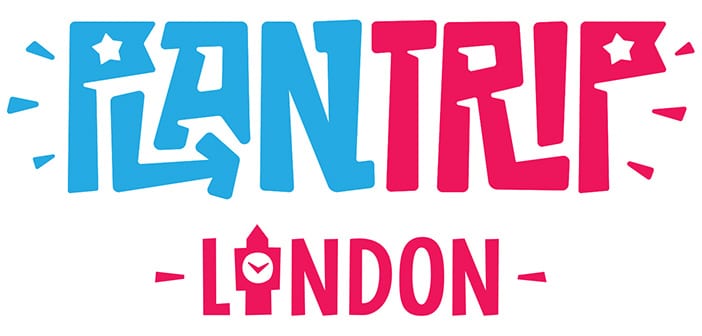

Travelling in London with kids

When planning a family trip to London, one of the things we need to think about is how we are going to get around London. And in particular, how travelling in London with kids works.
You are probably asking yourself what fares children have to pay on London´s public transport. And you may even need to know how to use London´s public transport with a buggy.
Travelling in London with kids: Fares and transport passes
When travelling in London with kids, it is important to know the different child fares on London´s transport network depending on their age. There are transport passes for children, valid for London´s underground network, buses, DLR, overground and trains within London travel zones .
Children under 11 years of age
Children aged under 11 travel free on London´s buses and trams, at any time, and do not need a ticket. They also travel free on London Underground, DLR (docklands light railway), overground and Tfl rail. They don´t need a ticket as long as a paying adult accompanies them.
Up to 4 children can travel for free with an adult with a valid ticket. When entering the London underground with a child (or more) under 11, it is advisable to use the larger access doors. These doors are wider and don´t close as fast as individual doors. They are designed for people travelling in London with kids, luggage or for disabled people.
Children 11 – 16 years of age
Children between the ages of 11 and under 16 can travel at a reduced rate on London´s public transport. Understanding what tickets are more suitable can be a bit complicated, as there are several options. For this reason, I am going to summarise the different options below. Hopefully, you will be able to decide which option is more suitable for you if you are travelling in London with kids.
Children from 11 to 16 years old can also travel with an adult oyster card or travel card if necessary. In this case, they will not benefit from reduced rates on travel.
Option 1: Oyster card with Young Visitor Discount
This is the best option if you are planning a family trip to London. An oyster card with a young visitor discount will apply half adult rates for 14 days. After 14 days, this discount will expire, and the oyster card will charge full adult rates again. The oyster card can also be returned at the end of your trip, just like a normal oyster card .
All you have to do is buy an Oyster Card or a Visitor Oyster Card, either online or at an underground station, and then ask a staff member to set the Young Visitor Discount. This discount can be applied at any underground station in London, including the underground station at Heathrow Airport .
An adult will need to give their personal details to register the oyster card before the discount can be applied, and you might be asked to confirm the child´s age. You and your child will need to be together when asking for the Young Visitor Discount to be set onto an oyster card, and an adult can request the young visitor discount to be set for up to 4 children (on separate oyster cards).
Option 2: Zip Oyster Photocard
The zip oyster photocard will entitle children up to 16 years of age to reduced fares on the underground and overground and other TFL services, as well as free travel on trams and buses. The zip oyster photocard is normally the best option for children that live in London, as the process to get an oyster photocard for a child can take some time and there is an initial registration fee of up to £20 – so this is normally not the best option for tourists.
- To get a zip oyster photocard if you live in London, all you need to do is fill in a form that you’ll find at your local Post Office and return it to the Post Office. You will also need to include a passport-sized photo and a copy of the birth certificate or passport and pay the fee. You should get the zip oyster photocard in 2 weeks.
- If you are a UK resident, you will need to do the process online on TFL’s website, and you should get the zip oyster photocard within 4 weeks.
- If you live outside the UK you will need to do the process online on TFL’s website. When applying, you will need to choose which London Visitor Centre (Liverpool Street Station, Victoria Station, Euston, Gatwick, King’s Cross station) you want to collect the zip oyster photocard from, as it will not be sent to your home address. You need to apply at least 3 weeks in advance but can apply up to three months in advance.
Option 3: 1 Day Child Travelcard
A one-day child travelcard will allow unlimited travel at any time of the day on any form of public transport in London for the chosen London Travel Zones . No ID is needed to purchase this one-day child travelcard, but fares using an oyster card with a young visitor discount are normally cheaper. If you are visiting London for several days and choose this option, you will have to buy a one-day child travelcard for each day, and this will work out a lot more expensive than using an oyster card with a young visitor discount.
Option 4: 7 Day Child Travelcard
To buy a 7-day child travelcard in London there are 3 options: 1 – By adding a weekly travelcard into a zip oyster photocard. This is undoubtedly the most complicated option, as you need to request a zip card oyster photocard first and then add the 7-day travelcard onto it. 2 – Buy a 7-day child travelcard online . This is probably the easiest way of getting one, as you don’t need a zip oyster photocard, and they’ll send it to your home address before you travel. 3 – Buy a 7-day child travelcard at a national railway ticket office (not an underground station).
16 – 18 years old
People aged 16 to 18 can also apply for a 16 – 18 zip oyster photocard, which will apply half adult rates on any form of public transport in London. Travelcards at a reduced price can also be added onto zip oyster photocards.
You don’t need to live in London to be able to apply for a zip card, but there is a processing fee which makes it hard to justify if you’re just visiting London for a few days. In this case, I’d recommend using a normal oyster card (adult rates) for anyone over 16.
For more information about travelling in London kids visit: Transport for London
Travelling in London with kids: Travelling to Central London from the airport
Stansted , Luton and Gatwick airports are all located outside London’s Travel Zones , so fares when travelling with kids too and from these airports are different to fares when travelling in London with kids, so under 11 years old’s will need a ticket.
An oyster card is valid for travel into Central London from Gatwick Airport, but children under 11 also need a train ticket to get to central London from Gatwick Airport, even if they are accompanied by an adult.
Heathrow and London City Airports are both inside London Travel Zones , so fares are as explained above. Children under 11 travel free, and Children under 16 can travel with an oyster card with a young visitor discount.
⇒ More information: London Airport Transfers
Travelling in London with a buggy
One of the things we need to think about if we are going to be travelling in London with kids is if we are going to need to travel around London with a buggy. If you are planning a trip with a baby, it may be that you wish to bring your buggy to London, or if you have older children, you will probably need to use a stroller if you are planning on spending the whole day walking around London.
When you first become a parent in London, using public transport with a buggy isn´t easy at first. Still, you eventually learn how to get around and quickly learn how to read London´s accessibility maps and find the best routes. The truth is that travelling in London with a buggy can be very easy if you know which route is best, or it can be a complete nightmare if you have to go up or down 300 steps when there are no lifts.
This is why we are going to explain how to travel on London´s public transport with a buggy.
Travelling on London´s buses with a buggy
Public buses in London have a dedicated wheelchair and buggy space as well as easy street-level access, and travelling by bus with a buggy normally is the easiest option to get around London. You can enter the bus via the back door, which makes it a bit easier too. Up to two pushchairs are allowed in the dedicated buggy space on a bus, but do bear in mind that during busy periods you may be asked to wait for the next bus or collapse your pushchair.
Travelling on the London Underground with a buggy
The trick to travelling in London with kids using a pushchair is to check London´s accessible underground map in advance and choose your route carefully. Being able to plan your route by choosing accessible stations makes life much easier. It may just mean that you need to get off at the next stop and walk 5 minutes, rather than having to take a buggy and a baby up 100 steps.
Unfortunately, not all underground stations in London are accessible. Most underground stations in London will have escalators, and many stations will also have stairs before reaching the platform. Many other stations have lifts to some platforms, and some stations are completely accessible, with lifts from the ticket office to the platform.
Travelling in London with a buggy is easier if there are two adults as one of you can carry the baby whilst the other one can take the buggy up or down the stairs. If it´s just one adult taking a buggy then I would encourage you to check the best route first. Whenever I had no choice and had to get off at an underground station that wasn’t accessible with a buggy, there has always been someone willing to help me. If you need help going up or down the stairs and you ask a staff member for help, for health and safety reasons, they will ask you to carry the baby and take the buggy for you. I have to say that a lot of people will use the escalators with a buggy, but I would recommend that you use stations with lifts.
London Underground Accessibility Maps
On the London Underground map, you will see that accessible underground stations are marked with the symbol of a wheelchair, in either a blue circle or a white circle.
- Blue circle: Fully accessible station. This means it is possible to go from street level onto the underground carriage without any steps. In these cases, the platform will have a slightly elevated area that avoids steps to get onto the train.
- White circle: Accessible Station. This means that there are no steps from street level to the platform. There is some unevenness when getting onto the train. This is important for someone using a wheelchair, but it usually isn´t a problem when taking a buggy onto the train.
In addition to this map, there is a Step Free Tube Map , which is a lot more detailed and the one I recommend you check when travelling on the London Underground with a buggy. This map highlights the degree of accessibility at each station in detail and explains how accessible it is to change between underground lines at different stations.
YOU MAY ALSO LIKE
- BEST LONDON MUSEUMS TO VISIT WITH KIDS
- 30 THINGS TO DO IN LONDON WITH KIDS
- BEST MUSICALS IN LONDON FOR KIDS
- THREE DAYS IN LONDON WITH KIDS
- TOP 10 LONDON ATTRACTIONS FOR KIDS
- FREE THINGS TO DO IN LONDON WITH KIDS
Related Posts
30 things to do in london with kids, christmas in london with kids, best theatre shows and musicals in london for kids, london underground.
Hi. Thanks for this useful info. I was wondering how a child can use an Oyster card reduced rates. My brother is visiting for five days with five and two children: 6 and 16yo. They will stay in zone four where the only connection to London is on a train. Therefore, do you think the cheapest way to get there each day and back is to use three adult Oyster cards? I read on TFL that children 5-11 can travel free on all sort of transport eleven without a zip photocard as long as they travel with accompanied adult. Of that’s the case, do they go through the gates together touching just with one card?
Hi Pawel, The cheapest way for the adults is to use an oyster card (or contactless debit or credit card ). The 6-year-old travels free, no ticket needed. They just go through the large gates (which are designed for families, disabled or people with luggage) with an adult. The 16-year-old can use an oyster card, like the adults, but will pay the same fare as the adults, but the best thing is to request they apply the young visitor discount on his oyster card at any underground station, paying half the fare than the adults for each journey. Hope that helps, I know it’s quite tricky!
Hi. Thanks for further explanation. I asked today at my local train station (national rail) in zone four and he advised me (although he didn’t sound entirely convincing) that the free travel for under 11s applies only on TFL transport and not on national rail even if it’s within London. Do you know if that’s the case as I read conflicting info on TFL.
Hi Pawel, this is my understanding too, children 5 – 11 need a ticket for national rail trains. Sorry I hadn’t realised you meant train, not underground! Let me know what station it is and I can look into it for you. =)
I’m visiting London with my two daughters (12 and 14). I thought I would get the visitor Oyster card and then ask for the family discount when we get there. How does this actually work going through the tap barriers? Do we all go through with one card?
Many thanks for your help with this! Michelle
Hi Michelle, As they are over 11 years old they need a card each – an oyster card with young visitor discount is the best option for them. Then each one of you will need to tap the card onto the yellow reader at the barrier to go through one by one. Hope that helps!
Many thanks! 🤗
Thanks a lot for the great information! I have a question regarding the young visitors discount. My daughter just turned 16 last month. Theoretically she won’t be able to get the discount, because on the official website it’s says only for children 11-15 years old. Am I missing something? Thanks!
Hi Anna, Yes, unfortunately the young visitor discount only applies to under 16s. As she is already 16, you would need to consider a zip card, or just a normal oyster card, as the zip card has a processing fee which probably makes it not worth it. Hope that helps!
Save my name, email, and website in this browser for the next time I comment.
Notify me via e-mail if anyone answers my comment.
Type above and press Enter to search. Press Esc to cancel.

- Places to Visit
- Sightseeing
- Practical Tips
- Where to Stay
Child Fares on London Transport
Last updated: 23 February 2024 Discounts for children on London transport are straightforward for children aged 10 and under. For children aged 11-15 it’s slightly more complicated.
Children under 5
Children under-5 travel free on all types of transport in London when travelling with an adult.
- up to 4 children are allowed per adult on London buses, the underground (tube), DLR and London Overground.
- up to 2 children under-5 travel free per adult on National Rail (trains)
Children aged 5-10
All children aged 5-10 travel for free on:
- the underground (tube), DLR, London Overground and some National Rail services within London as long as an adult accompanies them. Up to 4 children can travel per adult
- London’s buses with or without an adult
Children aged 11-15
Children aged 11-15 travel for free on London’s buses and at child-rate Pay as you go Oyster fares on the underground (tube), DLR, London Overground and most National Rail services if they have an 11-15 Zip Oyster photocard.
The child-rate single fare with an 11-15 Zip Oyster is 95p (peak) or 85p (off-peak) for zones 1-6.
Like the ordinary adult Oyster card, there’s a daily cap – the maximum amount deducted from the card in one day. It’s £4.25 peak and £1.80 off-peak for zones 1-2.
This is the cheapest deal for 11-15 year olds. The card is not available from underground stations, although you can apply online . It is available to non-UK residents but you’ll need to apply at least 3-4 weeks in advance. There’s also a non-refundable £15 administrative charge.
Travel in London without an 11-15 Zip Oyster
Applying for a 11-15 Zip Oyster is not worth the trouble unless you’re a resident or frequent visitor.
There are a few other options for young visitors that will save money:
- Young Visitor Discount on an Oyster card
- Child-rate One Day Travelcard (from an underground or train station)
- Pay the child full-fare (underground only, not bus)
Bus-only travel for 11-15 year olds
If an 11-15 year old does not have an 11-15 Zip Oyster, Visitor Oyster Discount or child-rate Travelcard the best option is to let them use your contactless debit/credit card and pay the adult-rate bus fare of £1.75. (NB only one card can be charged per passenger) or buy a £5.90 adult-rate one day bus pass . See London bus tickets & passes for details.
Young visitor Oyster discount
If you don’t want to apply for an 11-15 Zip Oyster, the cheapest way for 11-15 year old visitors to travel is the Young Visitor Oyster Discount. This is a special discount added to an ordinary Oyster card. It’s valid for 14 days. After 14 days, the discount automatically expires and the card can be used as a ordinary adult Oyster card.
There’s a £7 fee for the Oyster card (non-refundable). Single fares and the daily cap for the underground and buses-only are 50% cheaper than adult fares.
For example:
- Unlimited travel by underground in zone 1-2 is £4.25 per day
- Unlimited travel by bus is £2.65 per day, for the whole of London
It’s available from:
- Underground station ticket machines: you need to buy an Oyster card (£7) or use a Visitor Oyster Card. Ask a member of staff to apply the discount to the card via the ticket machine.
- Transport for London Visitor Centres
- Victoria train station ticket office
Children aged 16-17
Children aged 16-17 can apply for the 16+ Zip Oyster Photocard . With this they:
- pay Oyster Pay as you go fares at half the adult rate on the bus, tube and most National Rail services in London. (Children resident in London with a 16+ Zip travel free on the buses)
- can buy a child-rate weekly or monthly Travelcard.
You must apply online. There’s a non-refundable £20 administrative charge for the 16+ Zip Oyster. If you live outside the UK, you must apply for your card at least 4 weeks before arrival in London.
Without a 16+ Zip Oyster, a 16 or 17 year old is classed as an adult and must either:
- pay the adult fare
- buy an adult-priced Travelcard, bus pass
- use an ordinary Pay as you go Oyster card with an Oyster or Contactless payment.
18+ Students
Students aged 18+ resident in London during term-time can apply for an 18+ Student Oyster photocard. It might also be possible to apply for a 16+ Zip Oyster .
There are no other discounts for students not studying and living in London.
Child ticket prices (11-15 years)
11-15 zip oyster pay as you go single fares (payg) 2024, 11-15 zip oyster daily cap prices from 3 march 2024, child one day travelcard from 3 march 2024.
These are the prices for the Child One Day Travelcard.
Off Peak : Valid for travel after 09:30 Monday–Friday and all day Saturday, Sunday & Public Holidays. Anytime : Valid for travel before 09:30 Monday–Friday.
See London’s Transport Zones if you’re not familiar with the zones and the areas they cover.
Transport tickets & passes
- Guide to London's transport tickets
- One day & weekly Travelcards
- Zone 2–6 weekly Travelcards
- Bus tickets & passes
- Oyster card
- Oyster single tickets
- Oyster card refunds
- Contactless cards
- Child tickets & passes
- Local train tickets
Useful information
- Plan your journey
- London transport zones
Copyright 2010-2024 toptiplondon.com. All rights reserved. Contact us | Disclaimer | Privacy

Travelling in London with kids: Fares, Tickets and Advice
by Ren Nair Last Update: 19 Oct 2023
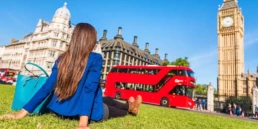
When planning a family trip to London…
…one of the things you’ll be thinking about is how are we going to get around London, and, how travelling in London with kids works. You’re probably asking yourself what fares children need to pay on London´s public transport and you may even want to know how to use London´s public transport with a buggy.
Choose your attraction combination and save
A great day out without compromise.

• Children´s fares when travelling in London • Travelling from the airport to central London • Travelling in London with a buggy
Travelling in London with kids: Fares and transport passes
When travelling in London with kids it is important to know that children will pay different fares on London´s transport depending on their age. There are transport passes for children, and these transport passes will be valid for London´s underground network, buses, DLR, overground and trains within London travel zones.
Children under 11 years of age
Children under the age of 11 travel free on London´s buses and trams, with or without an adult, at any time, and don’t need a ticket. Children under the age of 11 also travel free on London Underground, DLR (Docklands Light Railway), overground and TFL rail without a ticket if they’re accompanied by a paying adult. Up to 4 children can travel for free with an adult that has a valid ticket. When entering the London underground with children under the age of 11, it’s advisable to use the larger access doors. These doors are wider and don´t close as fast as the single doors and are designed for people travelling in London with kids, those with luggage or disabled passengers.
Visiting attractions with kids?
Keetoo stands out as one of the top choices for families seeking days out in London, offering substantial savings on gate prices while providing seamless access through the convenience of your phone. With everything stored digitally and total flexibility, Keetoo ensures hassle-free and enjoyable days out with the kids. Simply choose the places you wish to visit, who’s going with you and up pops the saving and you’re on your way!

Children from 11 to 16 years of age
Children between the ages of 11 and 16 can travel at a reduced rate on London´s public transport. There are several options and to make it simple, we’re going to summarise these below. Children from 11 to 16 years old can also travel with an adult Oyster card or travel card if necessary. But bear in mind, they’ll not benefit from reduced rates on travel.
Option 1: Oyster card with Young Visitor Discount
This is a great option if you’re planning on travelling in London with kids. An Oyster card with young visitor discount will apply half adult rates for 14 days. After 14 days this discount will expire, and the Oyster card will charge full adult rates again. The Oyster card can also be returned at the end of your trip, just like a normal Oyster card.
All you need to do is buy an Oyster card or a Visitor Oyster card, either online or at an underground station, and then ask a member of staff to set the Young Visitor Discount. This discount can be applied at any underground station in London, including the underground station at Heathrow Airport. An adult will need to give their personal details to register the Oyster card before the discount can be applied, and you might be asked to confirm the child´s age. You and your child will need to be together when asking for the Young Visitor Discount to be set onto an Oyster card, and an adult can request the young visitor discount to be set for up to 4 children (on separate Oyster cards).
Option 2: Zip Oyster Photocard
The Zip Oyster photocard will entitle children of up to 16 years of age to reduced fares on the underground and overground and other TFL services, as well as free travel on trams and buses. The Zip Oyster photocard is normally the best option for children that live in London, as the process to get an Oyster photocard for a child can take some time and there’s an initial registration fee of up to £20 – so this is normally not the best option for visitors.
You can get a Zip Oyster photocard if you live in London, all you need to do is fill in a form that you will find at your local Post Office and return it to the Post Office. You will also need to include a passport sized photo and a copy of the birth certificate or passport and pay the fee. You should get the Zip Oyster photocard in 2 weeks.
If you’re a UK resident, you’ll need to do the process online on TFL’s website and you should get the Zip Oyster photocard within 4 weeks.
If you live outside the UK you will need to do the process online on TFL’s website. When applying, you’ll need to choose which London Visitor Centre (Liverpool Street Station, Victoria Station, Euston, Gatwick, King’s Cross station) you want to collect the Zip Oyster photocard from, as it will not be sent to your home address. You’ll need to apply at least 3 weeks in advance but can also apply up to three months in advance.
Option 3: 1 Day Child Travelcard
A one-day child travelcard will allow unlimited travel at any time of the day on any form of public transport in London for the chosen London travel zones. No ID is needed to purchase this one-day child travelcard, but fares using an Oyster card with young visitor discount are normally cheaper. If you’re visiting London for several days and choose this option you’ll have to buy a one-day child travelcard for each day, and this will work out a lot more expensive than using an Oyster card with young visitor discount.

Option 4: 7 Day Child Travelcard
To buy a 7-day child travelcard in London there are 3 options: 1 – By adding a weekly travelcard into a Zip Oyster photocard. This is undoubtedly the most complicated option, as you need to request a Zip Card Oyster photocard first and then add the 7-day travelcard onto it. 2 – Buy a 7-day child travelcard online. This is probably the easiest way of getting one, as you do not need a Zip Oyster photocard and they will send it to your home address before you travel. 3 – Buy a 7-day child travelcard at a national railway ticket office (not an underground station).
People 16 to 18 years old
People aged 16 to 18 can also apply for a 16 – 18 Zip Oyster photocard, which will apply half adult rates on any form of public transport in London. Travelcards at a reduced price can also be added onto Zip Oyster photocards. For more information about travelling in London with kids visit: Transport for London.
Travelling in London with kids: Travelling to Central London from the airport Stansted, Luton and Gatwick airports are all located outside London’s Travel Zones, so fares when travelling with kids to and from these airports are different to fares when travelling in London with kids, so under 11-year old children will need a ticket.
An Oyster card is valid for travel into Central London from Gatwick Airport, but children under 11 will also need a train ticket to get to central London from Gatwick Airport, even if they are accompanied by an adult.
Heathrow and London City Airports are both inside London Travel Zones, so fares are as explained above. Children under 11 travel free and Children under 16 can travel with an Oyster card with young visitor discount.
Travelling in London with a buggy
If you are planning a trip with a baby or toddler, it may be that you wish to bring your buggy or stroller to London, especially if you’re planning on spending the whole day walking around London.
Travelling in London with a buggy can be quite easy if you know which route is best, or it can be a complete nightmare if you have to go up or down 300 steps when there are no lifts.
Don’t stress, we’re going to explain how to travel on London´s public transport with a buggy.
Travelling on London´s buses with a buggy
Public buses in London have a dedicated wheelchair and buggy space as well as easy street-level access. Travelling by bus with a buggy normally is the easiest option to get around London. You can enter the bus via the back door, which makes it a bit easier too. Up to two pushchairs are allowed in the dedicated buggy space on a bus but do bear in mind that during busy periods you may be asked to wait for the next bus or collapse your pushchair.
Travelling on the London Underground with a buggy
The trick to travelling in London with kids using a pushchair is to check London´s accessible underground map in advance and choose your route carefully. Being able to plan your route choosing accessible stations makes life much easier, and it may just mean that you need to get off at the next stop and walk 5 minutes, rather than having to take a buggy and a baby up 100 steps.
Unfortunately, not all underground stations in London are accessible. Most underground stations in London will have escalators, and many stations will also have some stairs at some point before reaching the platform. Many other stations have lifts to some of the platforms, and some stations are completely accessible, with lifts from the ticket office to the platform.
If you need help going up or down the stairs and you ask a member of staff for help, for health and safety reasons they will ask you to carry the baby and they will take the buggy for you.
London Underground Accessibility Maps
On the London Underground map, you will see that accessible underground stations are marked with the symbol of a wheelchair, in either a blue circle or a white circle.
• Blue circle: the underground station is fully accessible, which means that it is possible to go from street-level onto the underground carriage without any steps at all. In these cases, the platform will have an area that is slightly elevated to avoid any steps when getting onto the train.
• White circle: this means that there are no steps from street-level to platform, but there is some unevenness when getting onto the train. This is important for someone using a wheelchair, but it normally isn´t a problem when taking a buggy onto the train.
In addition to this map, there’s a Step Free Tube Map that is a lot more detailed and the one we’d recommend you check when travelling on the London Underground with a buggy. This map highlights the degree of accessibility at each station in detail and it also explains how accessible it is to change between underground lines at different stations.

Welcome to our Blog!
Hi, I’m Ren, a travel lover a mum of 2 and founder of Keetoo, a leading website and app for tickets for days out. On this blog, I share our family travel experiences with practical information, pictures and useful tips!
Join us for more tips on London and UK travel
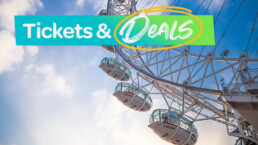
Explore London like a local
with our insider’s mini guide
Download for FREE now
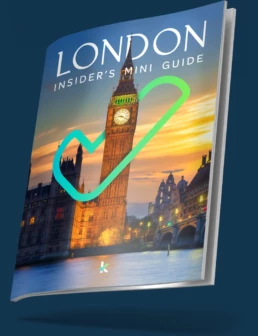
with our insider’s mini guide. Download for FREE now
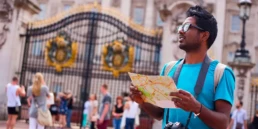
The Best Combination Tickets for London Attractions

Best Alternatives to the London Tourist Passes

Visit the best London attractions during Christmas 2023

10 of the best Christmas Markets in London 2023

The Best Christmas Day Out in London

Should I Book Tickets for London Attractions in Advance?
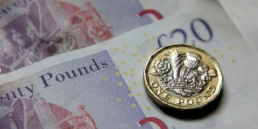
Affordable UK days out ideas on a budget

Things To Do for Father’s Day in London
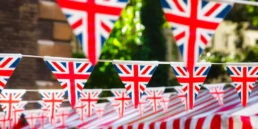
The Queen’s Platinum Jubilee 2022

11 Things to Consider When Making Plans to Visit Oxford from London
18 comments.
We are a family og 6 and looking for a decent hotel that won’t break the budget (as there are six of us) what is the best value 4 star (or even 5) hotel and we are they located?
The thing to be aware of is the star system only reflects the facilities offered by each hotel, not necessarily how good it is. It is only when you get to five-star level hotels that things like ambiance are taken into account. There are a variety of great hotels all over London. The best thing to do is to go through one of the main aggregators like booking.com – pick a budget, have a look at the area you would like to be in then have a look at reviews from guests that have been to the hotel most recently. This will give you the best insight as to the hotel that best fits your budget and then allow you to see the most recent guest reviews.
We have very young kids and are coming to London for the first time this summer. Is London and travelling in London easy with strollers and prams. It’s giving me nightmares thinking about getting around the city with them…any thoughts?
Overall, London is a fantastic city to explore with young children, and with some preparation and consideration, you can have a wonderful experience getting around with strollers and prams. Remember to plan your routes, check for accessible facilities, and be prepared for any weather changes, as London’s climate can be unpredictable.
We are London based but just don’t do touristy things and have friends coming over in the next few weeks. Any help on the best advice we can give then on getting out and about doing things. This will be their first trip in London but. they will be staying with us for around 3 weeks. Thinking of the major London attractions including the Tower of London, London Eye etc and perhaps a little further out??
London has so many touristy attractions to offer. Here are some quick ideas on what to do with your friends visiting for the first time: Visit the iconic landmarks: Take them so see must visit landmarks such as the Tower of London, Buckingham Palace (watch the Changing of the Guard ceremony), St Paul’s, Sightseeing Bus, and the London Eye for breath-taking views of the city from above and perhaps a relaxing river cruise to get a different perspective of the city. A great way to visit some of London’s best sights is with Keetoo which is super flexible and saves you every time if you’re looking to visit multiple venues. London is home to world-class museums and galleries. The British Museum, National Gallery, Tate Modern, and Natural History Museum are a few top choices that offer a diverse range of exhibits. Stroll through parks: Enjoy a leisurely walk-through beautiful parks like Hyde Park, Regents Park, and St. James’s Park. You can even have a picnic or rent rowboats in some of these parks. Take a Thames River Cruise: Experience London from a different perspective by taking a relaxing cruise along the river Thames. This provides excellent views of the city’s landmarks from the water. Shop at famous markets: Head to popular markets like Borough Market for delicious food, Covent Garden for shopping and street performers, and Camden Market for unique and alternative finds. Enjoy West End Theatre: Treat your friends to a memorable evening by watching a world-class musical or play in London’s West End theatre district. Discover historical neighbourhoods: Wander through charming neighbourhoods like Covent Garden, Notting Hill, and Greenwich, each with its own distinct character and attractions. Remember to check the opening hours and availability of tickets in advance for certain attractions. London has so much to offer, and your friends will surely have a fantastic time exploring the city’s rich history, culture, and entertainment options.
My daughter is in a wheelcgair and we are looking to go to the London eye – I have been told it doesn’t stop – Do you know if its easy to get wheelchair access and if so, how if its moving?
Yes it’s very easy – it has been designed very much so that people of all abilities have easy access. So there is no need to worry. Staff are very attentive too.
Do you know what is the minimum age for children at most London attraction some times it says 5-15 others 3-15. Why don’t they all just agree on one age range!!!!
Where is the best place to be located in London if we are looking to visit all the major sites?
The best place to be located in London for easy access to all the major sites would be in central London, particularly areas that are well-connected to public transportation. Here are some recommended neighbourhoods:
Westminster: This area is right in the heart of London and is home to many iconic landmarks such as Big Ben, the Houses of Parliament, Westminster Abbey, and Buckingham Palace. Staying here means you can easily walk to several major attractions.
Covent Garden: Located in the West End, Covent Garden is known for its vibrant atmosphere, theatres, shops, and restaurants. It’s within walking distance of attractions like the British Museum, Trafalgar Square, and Leicester Square.
South Bank: This area along the southern bank of the river Thames offers stunning views of the city skyline and is close to attractions like the London Eye, Tate Modern, Shakespeare’s Globe Theatre, and the Shard.
Soho: Known for its lively nightlife, Soho is centrally located and provides easy access to Oxford Street for shopping, as well as theatres, restaurants, and Chinatown. It’s also close to Leicester Square and Piccadilly Circus.
Kensington: A more upscale neighbourhood, Kensington offers proximity to major museums like the Natural History Museum, the Victoria and Albert Museum, and the Science Museum. It’s also near Hyde Park and Kensington Palace. Marylebone: This elegant area is close to Regent’s Park, Madame Tussauds, and Sherlock Holmes Museum. It’s well-connected by public transport, making it convenient for exploring other parts of the city.
When choosing accommodation, consider hotels near major Tube stations or bus stops to make getting around easier. London’s public transportation system is extensive, and you’ll be able to reach most of the city’s attractions quickly from central locations.Additionally, being centrally located allows you to make the most of your time and explore multiple sites without spending too much time on commuting.
If i want to just use my credit card to tap in and out on the London underground is that more expensive than buying and Oyster card?
Using your contactless credit or debit card to tap in and out on the London Underground is generally not more expensive than using an Oyster card. In fact, the fares for using contactless payment cards and Oyster cards are the same. Transport for London (TfL) introduced fare capping on contactless payments, which ensures that you won’t pay more than the cost of a daily or weekly Travelcard, depending on the number of journeys you make in a day or week. This is not the same for children however as you will be charged the adult amount. The benefits of using contactless payment cards include: No need to top up: With contactless, you don’t need to worry about topping up your card. The fare is automatically deducted from your credit or debit card account. Daily and weekly capping: If you make several journeys in a day or week, your total fare will be capped, providing cost savings compared to purchasing individual tickets. Same fares as Oyster: The fare structure is the same for both Oyster and contactless payment methods. Flexibility: You can use the same contactless card for public transportation throughout London, including buses, the Tube, DLR, London Overground, and TfL Rail services. However, before using your contactless card, ensure that your card is enabled for contactless payments and check with your bank or credit card provider for any additional fees or foreign transaction charges that may apply if you are visiting from abroad. Ultimately, using contactless payment for travel on the London Underground is a convenient and cost-effective option for most visitors and residents.
If you use the same credit card for the whole day it will be capped and no more than an all day travel card so will not work out more expensive than an Oyster Card. This is not the case though for children as you will get charged an adult amount.
We are coming into London for half term and don’t come in much so all a bit confused with what’s the best way to travel when in London. Also the best way to buy tickets to theatre attractions etc. We are a a family of four, what’s the best way to travel around on a budget for 4 days? Kids are 6 and 13. can you give any help or pointers to sites that can help would be gratefully received.
Visiting London for half term with your family can be an exciting experience! To make the most of your trip and travel around on a budget, consider the following tips: Oyster Card or Contactless Payment: For convenient and cost-effective travel, get Oyster cards for each member of your family. These can be used on London’s public transportation, including the Tube, buses, DLR, London Overground, and some National Rail services. Alternatively, you can use contactless payment cards (credit/debit cards) for the same fare capping benefits. Travelcards: If you plan to use public transportation frequently, consider buying a 7-day Travelcard or a Visitor Oyster card with a 7-day Travelcard loaded on it. This option allows unlimited travel within certain zones and can be more economical if you make multiple journeys daily. Kids Travel for Free: Children under the age of 11 can travel for free on the London Underground and buses when accompanied by an adult with a valid Oyster card or Travelcard. Children aged 11 to 15 can also travel for free on buses with an 11-15 Zip Oyster photocard. Keetoo: If you plan to visit attractions like the London Eye, Madame Tussauds, or the Tower of London, check Keetoo.com. An easy and affordable way to buy tickets meaning you’ll never pay full price and it offers a much more flexible way of booking – important when you’ve with the kids. Theatre Tickets: To get the best deals on theatre tickets, consider purchasing them in advance online from official websites or reputable ticket agents. You can also check for last-minute deals on the day of the show at the TKTS booth in Leicester Square. Family-friendly attractions: London offers many family-friendly attractions like the Natural History Museum, Science Museum, the Diana Memorial Playground in Kensington Gardens, and the Warner Bros. Studio Tour – The Making of Harry Potter. Half-term events: Check online for special events and activities taking place during the half term. Many museums, parks, and attractions offer seasonal programs for families. Visit London’s Parks: Take advantage of London’s beautiful parks like Hyde Park and Regent’s Park for picnics and outdoor activities. To plan your trip and find more information, you can visit the official TfL website (Transport for London) for travel details and attractions, and VisitLondon for ideas on things to do and upcoming events. Additionally, consider downloading apps like Citymapper or the TfL Oyster app to help navigate the city and check transport updates on the go. Enjoy your trip to London with your family!
We are visiting to London with our kids (aged 11 & 14 ) in half term and we are there for five days, what is the best tickets for us to purchase to get around? Whats the best place to be looking for advance attraction tickets with flexibility – happy to pay a little more for flexibility
For your five-day trip to London during half term with your kids aged 11 and 14, the best tickets to purchase for getting around would be Visitor Oyster cards with a 7-day Travelcard loaded on them. This option allows unlimited travel within certain zones and offers flexibility for using various modes of public transportation during your stay. If you’re looking for advance attraction tickets with flexibility, Keetoo is one of the best options to consider. It offers a flexible and convenient way to purchase attraction tickets in advance while providing both savings and flexibility. You can access multiple attractions across London with a single app, which can save you both time and money compared to buying individual tickets for each attraction. Benefits of using Keetoo for attraction tickets: Savings: Keetoo always provides discounted prices compared to buying separate tickets for each attraction [as long as you are looking to visit more than one attraction]. Flexibility: The app allows you to visit attractions on different days, giving you the freedom to plan your itinerary based on your interests and your schedule. Ease of Use: Keetoo’s tickets are stored on your phone, making it convenient to access and use at various attractions without the need for physical tickets. Wide Range of Attractions: Keetoo offers access to a variety of popular attractions, ensuring there’s something for everyone in your family to enjoy. To get the most out of your visit, make sure to check the list of attractions included on the Keetoo website and plan your days accordingly. Enjoy your trip to London with your family and have a fantastic time exploring the city’s attractions!
Add comment Cancel reply
Save my name, email, and website in this browser for the next time I comment.
Privacy Preference Center
Privacy preferences.
How to Pay for Kids on Public Transport When Visiting London
We often get asked about how to pay for kids on London’s public transport, and although it’s actually pretty straightforward, it differs depending on the child’s age. So, we’ve broken down some of the most commonly asked questions so that your next trip with the kids in the city is as seamless as possible. Please note that this article is relevant to London transport only and not trains outside the city.
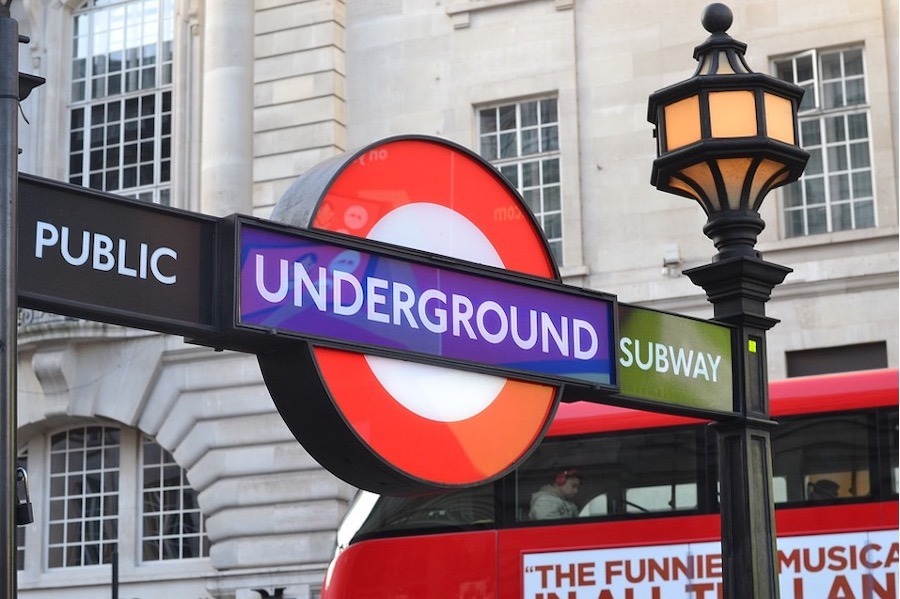
Do kids have to pay to use public transport in London?
It depends on how old they are.
Under the age of five
If your child is under the age of 5, they can travel for free at all times on London’s transport system. This covers buses, the London Overground, the Tube, DLR, Uber Boats and the IFS Cloud Cable Car (formerly Emirates Air Line Cable Car), which offers aerial views of the city’s skyline. But, they can only travel for free if they’re travelling alongside a fare-paying adult.
Aged between five and ten
Again, children aged 6 and 10 can travel at no cost on London’s Tube, DLR and London Overground, as long as they travel with a fare-paying adult. They do not need an Oyster card, and up to four children can travel at any time with one paying adult. However, if you want to see London from up high on the IFS Cloud Cable Car, children between 5 and 15 will only need to pay child rates.
If you plan to travel by Uber Boat at least a couple of times in a day, you’re best off purchasing a Family River Roamer ticket , where you can hop on and off an unlimited amount of times; it’s valid for two adults and three children aged 5 to 15 years.
Aged between 11 and 15
Kids 11 to 15 do have to pay for transport, but they can get 50% off their fares for up to 14 days with the Young Visitor Discount. To get this, you’ll need to buy an Oyster card , a transport card that costs £7 (non-refundable), and can be topped up at stations with credit which allows you to travel. Once you have your card, ask a member of staff at any tube or train station to add the Young Visitor Discount to it. Just be sure to have your kid with you when you ask for this.
This works in the same way as any regular paying adult. However, if they don’t have a contactless card or Apple Pay/Google Pay, then it’s best to purchase them an Oyster card that they can then top up.
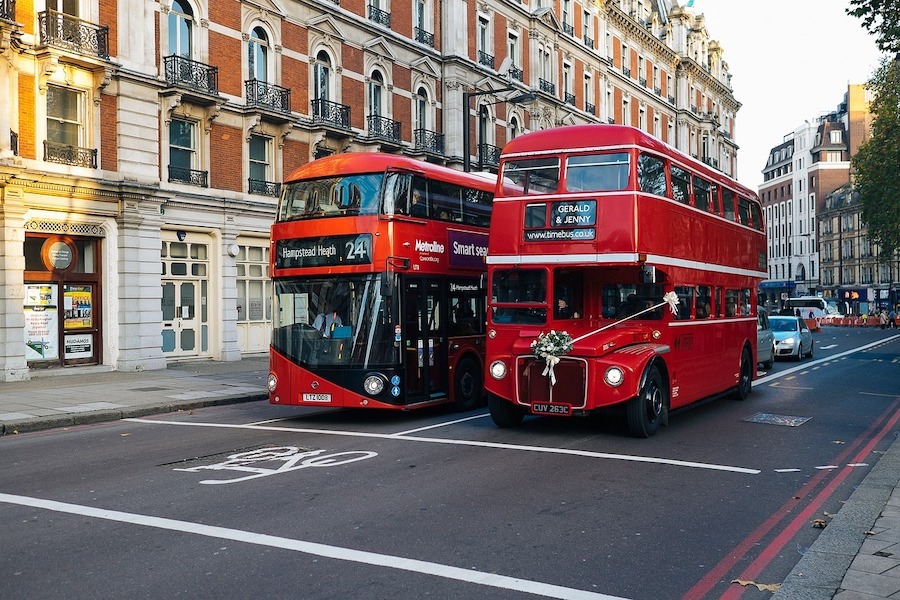
Does every kid need a payment card?
Kids under 11 do not need a payment card. But aged 11 and above do, and as mentioned above, Oyster is usually best.
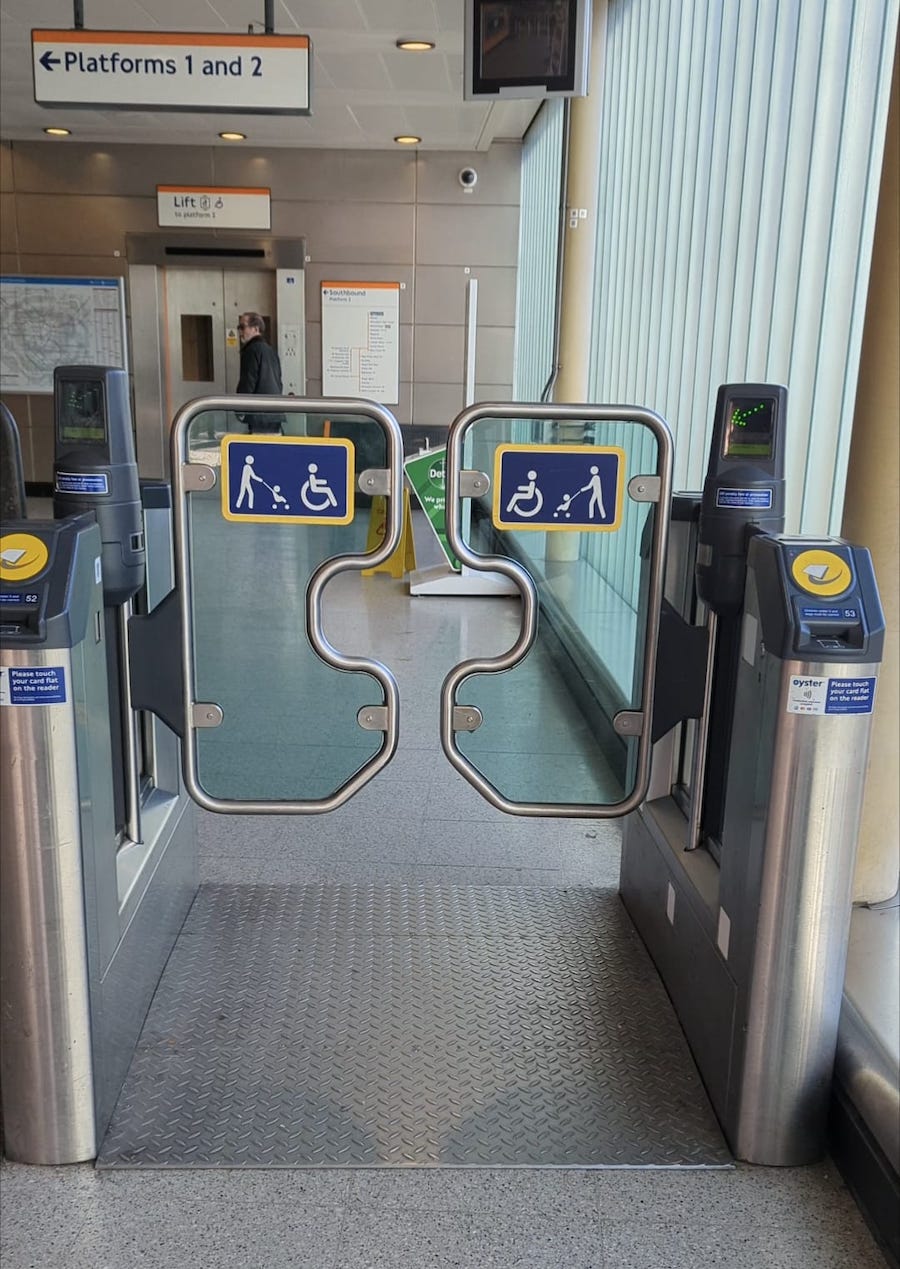
How do you take kids under 11 onto the tube without their own card?
At all stations, there will be a row of narrow ticket barriers where you can enter in and out using your contactless card, Oyster card or paper ticket. Alongside these narrow barriers, there will always be wide barriers (usually two) at the end of the rows designed for people travelling with suitcases, kids, dogs and larger items, so use those (see the picture above). These are made so that people can go through the barriers without getting accidentally trapped on the way through.
For the bus, just take the kids on, pay your own fare and find a seat.
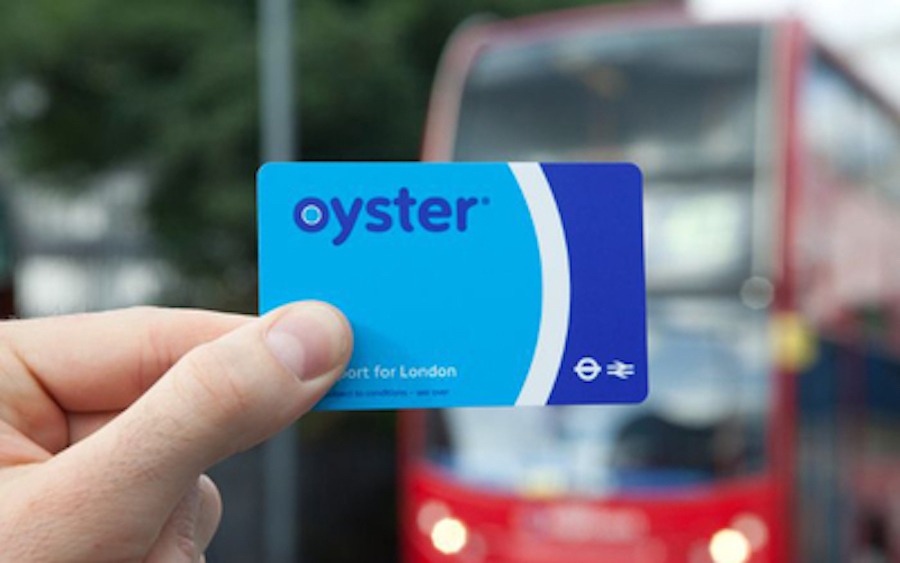
Do adults need Oyster cards to travel in London?
There are three main ways that adults can pay for public transport in London: Oyster card, debit or credit card and Apple or Google Pay. Oyster cards are not required when using the city’s transport system, but there are some things that you’ll need to familiarise yourself with before visiting. Take a look at our recent guide on how to pay for public transport in London to get an in-depth understanding of the best ways you can pay for transportation in the city.
Hope we helped you figure out how to pay for kids on London’s public transport. Have a great time!
How to Pay for Public Transport in London
Unique Things to Do with Kids In London
Best London Hotels for Families
Pin this…
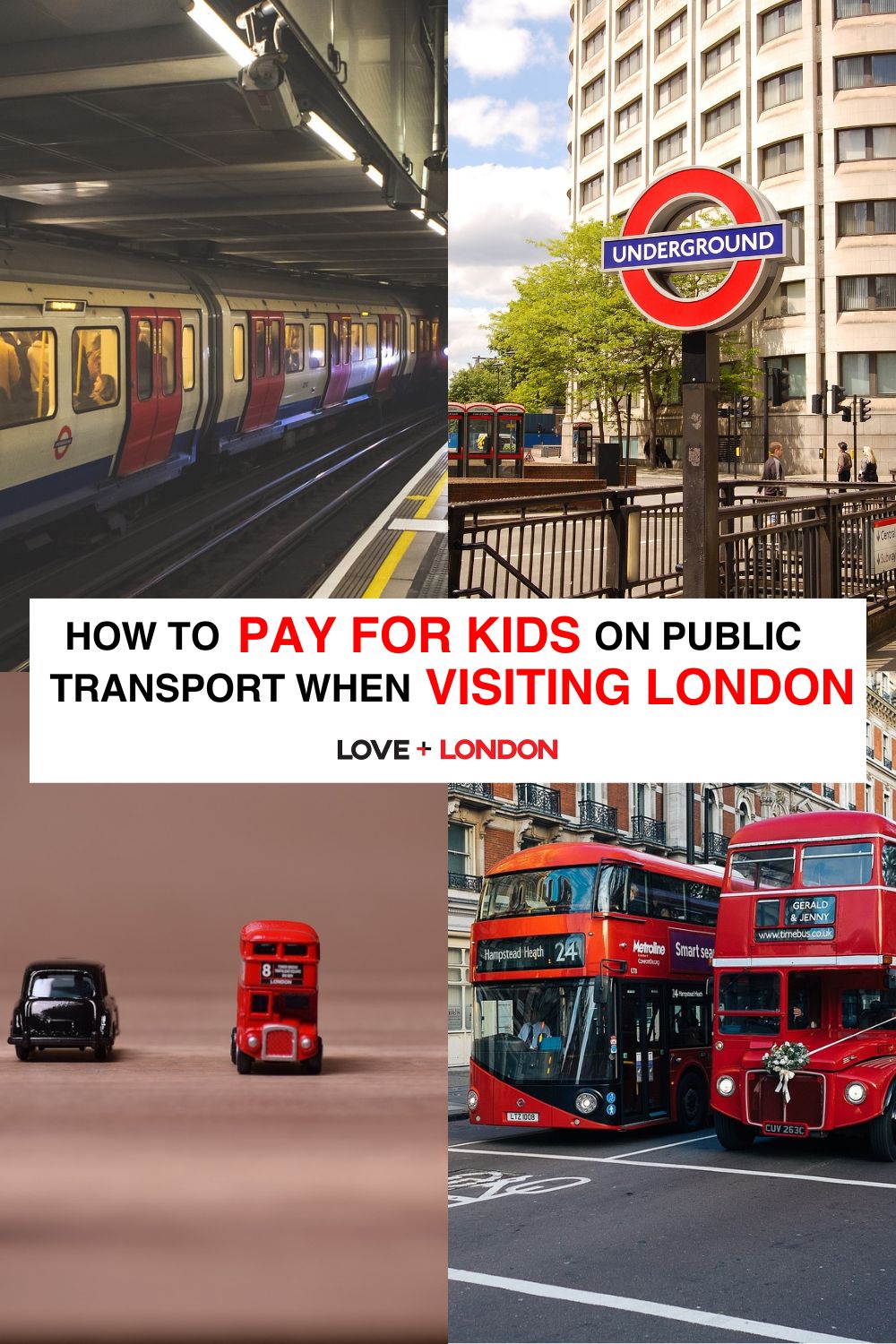
Jessica Dellow
Jessica Dellow is an East Londoner who loves to travel the world and eat her way around the city. When she's not eating, cooking or hanging out in the local pub, you’ll probably find her walking one of her BorrowMyDoggy dogs in Victoria Park with a coffee in hand.
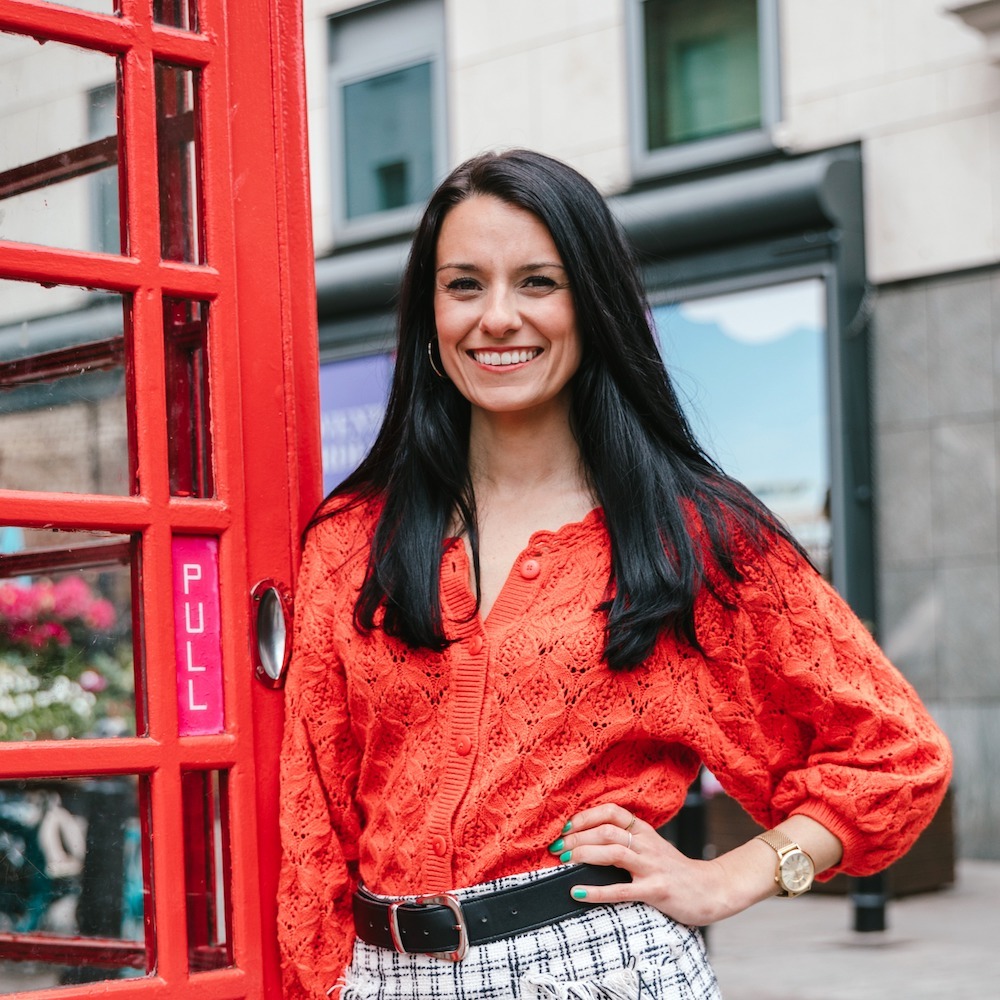
Jess Dante - Founder
Search this site
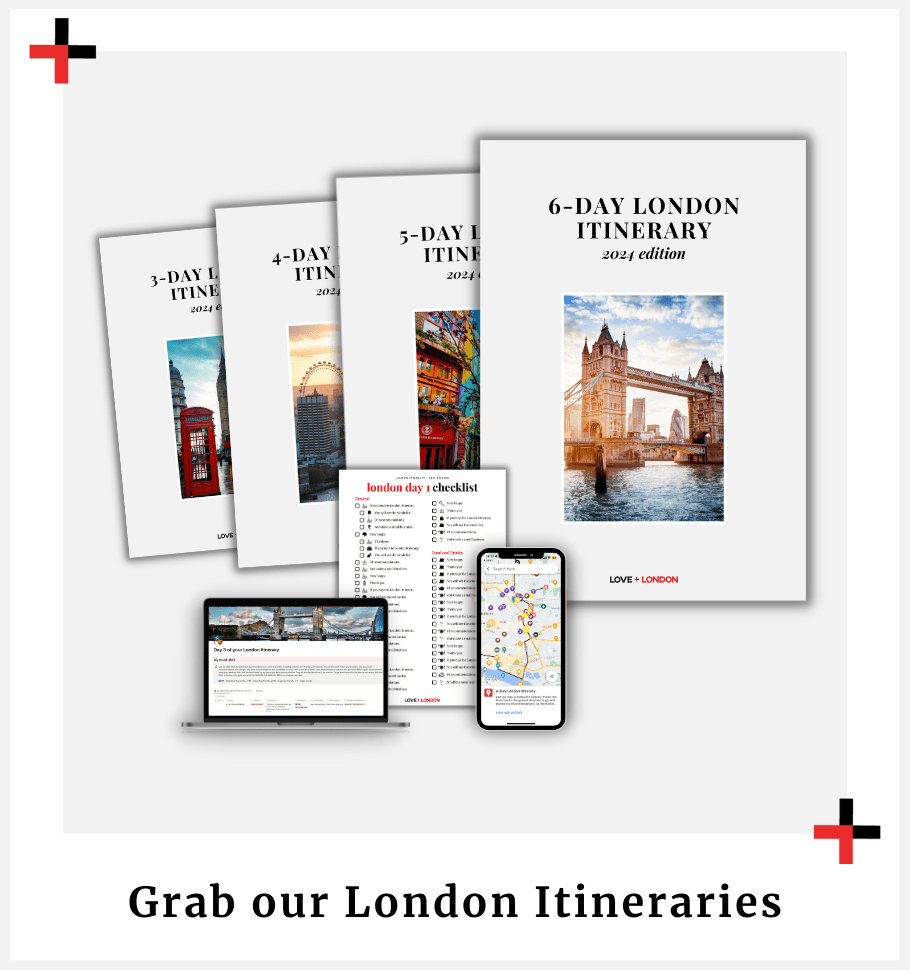
Previous Post Delicious Vegetarian-Friendly Restaurants to Try in London
Next post unique things to do with kids in london, related posts.
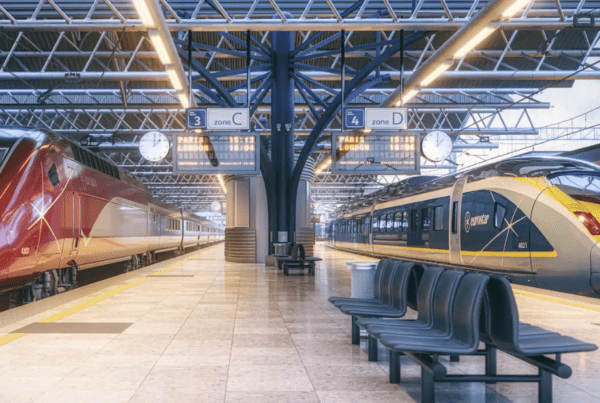
Hi I’m Jess, the founder of Love and London. My team of locals and I help London tourists avoid the overhyped and overdone, so they can have the trip of a lifetime.
- London Itineraries
- Casual Tourist Guides to London
- London Spending Guide
- Free London 101 Guide
- Free London Trip Checklist
- London Packing Guide
- London Planning Tips
- Find Your Perfect Accommodation
- London Area Guides
- London Food + Drink Scene
- Things to Do in London
- Top London Tours and Experiences
- London Transport
- London with Kids
- Wheelchair Accessibility
- Festive Season Guides
- London Photo Sessions
- Book your airport transfer
- London FAQs
- Work with Love and London
- How To Say “Thanks”
- Press + Features

Before you go, check this out!
We have lots more on the site to show you. You've only seen one page. Check out this post which is one of the most popular of all time.
Travelling around London with Children
The centre of London between attractions isn’t as large as you may think and a short walk, with the kids, a bus ride or tube journey is all that will eb needed. Moving further afield, the underground is generally the best and fastest way around and is child-friendly.
Is It Easy to Travel with Kids in London? Although London is a busy place, travelling with kids on buses, the underground or by black cabs are the easiest and safest options. Many attractions are only a few minutes’ walk from each other or a short tube ride.

Taking children to explore London is a great family day out and the abundance of public transport makes it easy to move from place to place.
Let’s run through the options.
10 Ways to Travel Around in London with Children
1. By bus 2. By underground (the tube) 3. By the Docklands Light Railway (DLR) 4. By mainline train 5. By a black cab taxi 6. By minicab 7. By car 8. By bicycle 9. By river 10. On foot
1. London by Bus with Children
London is famous for its bright red buses and you will not be disappointed – there are over 1,000 of them on the roads at any one time.
The kids will want to climb the stairs and travel on the top deck, so they can see everything there is to see. Take care of the younger ones, as there is a good chance the bus will have started to move before you all reach the top.
Buses in London run between 05:00 am and 12:30 am although can be less frequent on some routes during the evening. Overnight, there are night buses running on many routes, which shows the prefix N with their number.
During the morning and afternoon peak times, buses can be both frequent and very busy. Peak times are 08:00 am to 09:30 am and again between 4:30 pm and 6.30pm. In some places, schools finish at around 3;00 pm and you can find yourself surrounded by noisy children on what is generally known as the ‘buses from hell’.
Due to the volume of traffic, bus travel can be quite slow, although, with an increasing number of dedicated bus lanes, they are often faster than cars.
You can only board and alight from a London Transport bus at a proper bus stop. At each stop, you will see a list of the bus numbers which stop there. Although there are two types of bus stops, compulsory and request, it is best to raise your hand as the bus approaches to make sure the driver sees you and stops. As you approach your destination stop, ring the bell once so the driver knows you want to alight.
Travel cards or using an Oyster Card provide the best value.
2. London Underground (The Tube) with Children
The London Underground is the fastest way to travel around the capital and the extensive network can take you close to most places you are likely to visit.
First-time travel for children on the tube can be a bit daunting, yet very exciting. As well as hoards of people, there are very long escalators to contend with and people walking past them. The trains as they approach the platform can be quite noisy and may frighten young children the first few times. Others love the rush of air pushed in front of the train as it approaches.
Trains run Monday to Saturday from around 5:00 am to 12:30 am, and between 07:30 am and 11:30 pm on Sunday. On Friday and Saturday nights, there are night trains on some lines. The network is closed on Christmas Day.
There are 11 different colour-coded tube lines which make journey planning easy. Some routes go from end to end, but several have branch lines. The distinctive Underground map is displayed at every station and is available as a handy app for your phone, so do download that.
There are ticket machines at each station where you can use cash or a card to purchase your ticket. There are limited members of staff to help you. Once you have your ticket, go through the barrier remembering to pick your ticket out of the machine. Go down the stairs, the escalator or lift to platform level. Follow the sign to the line you need, remembering that some stations have multiple lines.
With the escalators, always stand on the right as you can expect the locals to rush past you on the left and if you are in the way, they can be quite vocal.
Watch for the display boards to see which train is due next and its destination. It may be that you will have to wait for more than one train before the one you need arrives. Check the map boards so you know which destination train you need.
On arrival at your destination, use the barrier machines to exit. This time, unless you have a return ticket, the machine will retain it.
The London Underground is divided in to six separate charing zones, with zone one in the centre on zones six at distant ends. There are also zones seven, eight and nine which extend it to and beyond Greater London.
If you in London for more than a day, then an Oyster card can save you money on the underground and on the buses.
3. Docklands Light Railway (DLR)
The DLR. is an overland rail system which runs principally to the east of London. They link the City with the now developed Docklands area
The trains are automated and driverless. This is great fun for children, who can sit right at the front and pretend to drive the train!
There are several interlinked routes and you may have to change DLR trains to reach your destination. London City Airport, which is only nine miles from the centre of London is served by the DLR.
DLR trains run from 05:30 am to 12:30 am Monday to Saturday and 06:30 am to 11.30pm on a Sunday and are closed on Christmas Day. Like the underground and buses, peak times for travel are 08:00 am to 9.30 m and 4:40 pm to 6.30 pm on weekdays.
Oyster cards and travelcards can save you money.
4. London by Train with Children
If you live outside London and are travelling in for the day, the mainline trains offer good connections from much of the country.
The kids will be ready for their big day out and the train journey is the first part. Mainline stations feed into London from all directions and each reaches a terminus, such as Waterloo, Charing Cross, Paddington, King’s Cross and many more.
All mainline station terminuses are attached to the London Underground, making it quick and simple to hit the attractions as quickly as possible.
Rail fares can be expensive, but with a little planning, costs can come down. Family Railcards need to be bought in advance and can reduce the cost of travel by a good percentage. Depending on where you want to go in London, a combined Travelcard covering mainline rail and the underground inner zones will work well. Deals change frequently, so check your local rail company for details.
5. London Taxis and Children
London’s distinctive black cabs are an icon around the world and no visit to London is complete without at least one trip.
There is nothing quite like a first London taxi ride for youngsters. Remember to take a picture or two of them in the cab.
London ‘cabbies’ have to pass a tough test know as ‘The Knowledge’ in order to hold a licence. This is not the case with any other public ire drivers. Your cab driver will know exactly where your destination is and can work out the shortest or fastest route in their heads. It is quite a skill.
You can tell if a black cab is available, by the yellow ‘TAXI’ light on the roof when it is illuminated. Hail a taxi by raising your arm in the air. Black cabs can also be found at rail stations, airports, some hotels and other formal taxi ranks across the city.
Does a black cab have to take you wherever you want to go? Well, yes and no. The yes is that when they have stopped, they are obliged to take you up to six miles from your pock-up point and inside the Metropolitan area. The no is that they can decline your fare if it falls outside this criterion. However, many will take you a greater distance if you ask, but they have the right to decline.
The fare is shown on a meter which seats as you enter the cab. This is based on a. Combination of distance and time and you will see the cost increase as you had towards your destination. There are different tariff rates operating between 06:00 am and 08:00 pm on weekdays; 8:00 pm and 10:00 pm on weekdays and between 06:00 am and 10 pm on weekends. Expect to pay more outside these times and on bank holidays.
Tipping a cab driver between 10% and 15% of the final fare is normal.
6. London Minicabs
London has a myriad of minicab companies and individuals. Theoretically, these should be licenced, but there are some rogue drivers out there, so take care.
The rise of Uber and Lyft has brought thousands of one-person operated cars on to London roads and these can be a blessing or a curse. The blessing being there is more choice and the curse id more traffic jams.
Many minicab drivers don’t have anything close to the knowledge of London you will find with black cabs and may not drive the most efficient route.
With a mini-cab, always agree on the fare before you enter the car.
7. London by Car
Are you sure? Really sure?
London is a very busy and congested city and best suited to public transport rather than driving by car. Central London in particular can be extremely slow, especially during morning and afternoon rush hour. Roads outside the centre can also be very busy with plenty of stop-start travel.
In the centre, the Congestion Zone attracts a daily fee of £11.50 (07:00 am to 6:00 pm Monday to Friday) which has to be paid on the day. If you register online ahead of travel, the cost comes down to £10.50. The rate increases if you pay the following day and after that, a fine of £130 is due. The system uses ANPR (Automatic Number-Plate Recognition) technology for identification. If you hire a car and don’t pay, your hire company will change our card and may add an administration fee on top.
Parking on London is generally in pay-and-display roadside bays or car parks. Payment can be by cards, telephone or increasingly phone apps only. If you park in the wrong place or overstay your welcome, you could find the vehicle is either clamped or towed away. This is where things start to become expensive.
All that said, driving in London isn’t the end of the world and there are numerous car hire companies to help you with short term use of a car. Many hire companies offer delivery of a car to where to are staying and they can also be picked up from airports.
8. London by Bicycle
Bringing children into the centre of London with bicycles isn’t recommended.
The roads are very busy and congested in the centre and the pollution levels from cars and lorries is intense in places. The further out you go, the better it will be. Helmets are essential in London.
Bicycle hire services operated from many spots across the city where you swipe a card, pick up a bike and you are on your way. These hire bikes, which are quite heavy and not designed for children, can be dropped at a different point. The whole service is automated.
Whether you have your own bicycles or are hiring, make sure you always lock them to somewhere secure, to avoid theft.
9. London by River Bus
What better way to see London, than from the River Thames?
There are regular river bus services run by Transport for London, which runs four routes between Putney and the west and Woolwich Arsenal in the east.
The timetable for river buses varies during the year depending on the season.
As well as the TfL routes, there are other river tours and cruises available.
10. London on Foot
You can stroll along the riverbanks, run in the parks or stroll around the streets.
London is a big place, but many attractions are close together and a walk will often reveal some interesting buildings or places to explore.
If you are keen walkers, there are numerous guided walking tours, covering anything from Jack the Ripper, to Harry Potter film locations.
RELATED ARTICLES
Talking of transport, the London Transport Museum is a great place to see vintage buses, trams, and underground engines and has plenty to keep the kids amused.
Nigel Peacock
Lover of London and exploring and writing to share our city with you.
Recent Posts
Visiting Downing Street, London - What to See
The door of number 10 Downing Street is one of the most famous in the world. What is Downing Street? Home to the British Prime Minister and the centre of the British Government. There is very...
Visiting Westminster Abbey, London - What to See and Do
There are few buildings in London that can match the majesty of Westminster Abbey, which is a UNESCO World Heritage Site. What is Westminster Abbey? A royal church offering daily services and a...
A Guide to Free Transport in London for Children
Depending on your child's age they can travel free or enjoy reduced rate travel on public transport throughout London. This can really help keep costs down when visiting London as a family.
Children over 5 can travel unaccompanied on London transport but it would be unusual to see young children traveling alone. Most primary school children in London (under 11s) are escorted to and from school by an adult (parent/carer).
Check TfL's useful guide and route maps to learn more about traveling with children.
Children Under 5
Children under 5 travel free at any time on London buses, the tube , trams, Docklands Light Railway (DLR), and London Overground trains when accompanied by an adult with a valid ticket.
Children 5 to 10 Years
Children under 11 can travel free on the tube, DLR, Overground and TfL rail services when accompanied by an adult using pay as you go or with a valid ticket (up to four children can travel per adult). If children are traveling alone they'll need a 5-10 Zip Oyster Photocard in order to travel for free.
If children do not have a valid Oyster photocard, they must pay the full adult fare on National Rail services.
In order to apply for a 5-10 Oyster Photocard , a parent or guardian must create a web account and complete a form on behalf of the child. You'll need a color digital photo of the child and you'll need to pay a £10 admin fee.
Children 11 to 15 Years
All 11-to-15-year-olds need an Oyster Photocard to travel free on buses and trams. They must also touch in/out (place their Oyster photocard on a reader to document the journey) as they board a bus or at the tram stop before boarding to avoid a penalty fare. 11-15-year-olds can travel off-peak on the tube, DLR, and London Overground for a maximum of £1.30 a day with an Oyster photocard.
In order to apply for an 11-15 Oyster Photocard , a parent or guardian must create a web account and complete a form on behalf of the child. You'll need a color digital photo of the child and you'll need to pay a £15 admin fee.
Children 16 to 18 Years
16 to 18-year-olds who are in qualifying full-time education and live in a London borough can travel free on buses and trams with a 16+ Oyster Photocard. Other 16-17-year-olds can get a 16+ Oyster Photocard to travel at half the adult rate.
In order to apply for a 16+ Oyster Photocard, a parent or guardian must create a web account and complete a form on behalf of the child. You'll need a color digital photo of the child and you'll need to pay a £20 admin fee.
Visitors to London
Applications can be made in advance for a 5-10, 11-15 and 16+ photocards for collection on arrival in London . Visitors can apply online or ask for an application form to be sent to you. You need to apply at least 3 weeks in advance or you can simply sort it out when you arrive at any London Underground station. Be sure to bring some passport size photos.
Students aged 18 and over attending a full-time course at a university, college, or school should contact their education provider to see if they are registered with the 18+ Student Oyster photocard scheme. This allows the purchase of Travelcards and Bus Pass season tickets at 30% off the adult rate.
How the Airlines Handle Unaccompanied Minors
How to Find Your Nearest US Passport Office
US Ski Resorts Where Kids Ski Free
How to Enjoy a Quick Layover in London on a Budget
Stay Cheaper By Staying Close to - Not in - London
London Travel: Which Oyster Card is Best for Visitors?
Southwest Airlines Unaccompanied Minor Policy
20 Best Things to Do in London When It Rains
Getting Around Beijing: Guide to Public Transportation
Visa Requirements for Finland
Getting Around Paris: Guide to Public Transportation
How to Travel from London to London City Airport by Underground and Taxi
20 Fun Places to Take the Kids in NYC
Do Children Need a Passport to Visit Canada?
Getting Around London: Guide to Public Transportation
Passports and Mexico Entry Requirements for Children
RELATED LINKS
On this page, fare zone maps (pdf), public transport london, fares & payments, london airport transfers, cruise port transfers, travel to / from london, most popular tours.

- Guide to hotel areas
- Bed & breakfast
- Backpacker hostels
- Airbnb London
- Central London tours
- Tours from London
- Hop-on hop-off bus tours
- Harry Potter tours
- Stonehenge tours
- Downton Abbey tours
- Windsor tours
- Cotswolds tours
- Private tours
- Ticket & pass offers
- Central London attractions
- Attractions outside London
- Harry Potter attractions
- Tower of London
- PUBLIC TRANSPORT
- London City
- London Southend
- Southampton
Child fares on London’s Underground, buses & transport 2024
Identifying child fare concessions available to your child with previously asked questions.
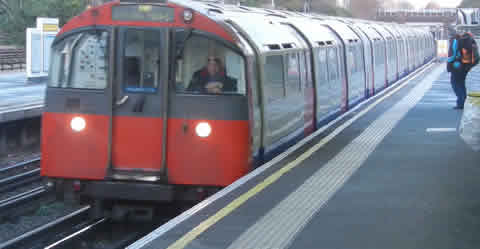
Child fares on London's Underground and buses are very complicated and fragmented.
Every year on January 2, ticket regulations and prices are reviewed and regularly child fare rules and options are tinkered around with as well as the adjustments to prices.
This page tries to explain as simply as possible the situation for your child, together with some workarounds to get around some of the restrictions. At the bottom of this page we also have some commonly asked questions on the subject of child fares in London.
At one extreme your child may travel free everywhere, at the other end of the spectrum if unprepared you may end up paying adult fares – so it's worthwhile making sure you understand the subject.
Child fare entitlement Young visitor discount Child Oyster cards Other options Previously asked questions

Free and reduced child fare entitlement by age band
Children under five can travel free at any time on all public transport without a ticket as long as they are accompanied by an adult with a valid ticket.
Children 5-10 years old
Under-11s can travel free at any time on London's buses and trams without a ticket.
They can also travel free at any time on the Tube, London Overground and DLR (Docklands Light Railway) when they are travelling with an adult who has a valid ticket. Up to 4 children under 11 years old accompanied by a paying adult travel free on the London Underground.
Unaccompanied children between 5 and 10 must have a valid 5-10 Zip Oyster Photocard for free travel. (Ah yes, the Photocard we'll come back to these further down the page).
On trains in the London area run by the national railways children between 5 and 15 need a child ticket. Most visitors do not use train services run by the national rail companies as they are essentially commuter services from the suburbs.
Which trains within London are are run by national rail companies
To the visitor it is becoming increasingly difficult to explain which surface rail lines within London are run by the national rail companies and which offer free travel to 5-10 year olds.
Very crudely speaking, if your surface train (not Underground train) runs from Paddington, Marylebone, Fenchurch Street, London Bridge, Blackfriars, Charing Cross, Waterloo or Victoria it will almost certainly be a national railways train.
For visitors the most popular trains used within London that are national rail run are Waterloo to Hampton Court and Waterloo or Paddington to Windsor.
Children 11-15 years old
Unaccompanied children aged 11 to 15 years must get an 11-15 Zip Oyster Photo card to travel free on buses and trams and at child rate on Tube, DLR and London Overground services using an Oyster card (see Oyster Photocard section below).
You can buy child rate Travelcards and single one-way child tickets on the Underground, railways and DLR, but not the buses.
For most visitors staying in London for 2 weeks or less with children between 11 and 15 the ticket of choice is an adult Oyster card loaded with a Young Persons Discount.
The Young Persons Discount has its own section further down the page.
Children 16-17 years old
In the UK you become an adult when you are 16. However in London it is possible to get child fares by getting a 16+ Zip Oyster photocard.
It is very similar to 11-15 Oyster Photocards, but you cannot use it to buy 1 Day Travelcards.
For short-term visitors, for most it is not a realistic option because of the expense and time required to obtain an Oyster ID Card - you'll just have to accept your child is an adult while in the UK.
Student 18+ years
If you are studying at a recognised educational establishment in London that is registered for the scheme and you are residing in London you can apply for a Student 18+ Oyster ID card.
This enables you to get 30% discount off bus and Travelcards of 7 days or longer.
The Young Visitor Discount - for children between 11 & 15 in London less than 15 days
The Oyster ID Card required by children between 11 and 15 to get child rate fares on Oyster is for most short-term visitors not a realistic proposition.
The cost, hassle and time to process the ID card is just not worth the effort. The Young Visitor Discount scheme has been created as the answer for short-term visitors who have children between 11 and 15.
The Young Visitor discount gives half adult rate pay as you go fares on bus, Tube, tram, DLR, London Overground and most National Rail services for up to 14 days and gives your child a daily cap half that of an adult.
After 14 days the discount will expire and the Oyster card will charge full adult rate fares.
The discount can be set on both regular Oyster Cards and Visitor Oyster cards.
Oyster Cards - more details
The Young Visitor Discount can only be set onto Oyster Cards and Visitor Oyster Cards at:
- Any Underground station (including Heathrow Airport). Although there are no longer manned ticket offices at Underground Stations members of staff will be available in the ticket hall with the ticket machines. Just make contact with a member of staff to have the Young Visitor Discount loaded onto the Oyster.
- Visitor or Travel Information Centres (Gatwick & Heathrow Airports, Liverpool Street, Euston, Paddington and King's Cross Railway Stations and Piccadilly Circus Underground Station)
- Victoria Station National Railways Ticket office
- TFL Rail station ticket offices
To get the Young Visitor Discount:
- You and your child must be together at the ticket office when asking for it to be set
- One adult can get the Young Visitor Discount set for up to four children
Child Rate Oyster Cards & Oyster Photo ID Cards
The Oyster ID Card is no real problem if you are a London resident with a young child. Take a little time for the initial registration process to get your Oyster Photocard and that's your passport to free and half price public transport until you are an adult. When you want a child travel product, just produce your Oyster Photocard.
For visitors it's a lot of hassle and expense to procure an Oyster ID Card and often it's too late when you do find out the hoops you have to jump through to get child fares via the Oyster Photocard.
If you are a short-term visitor the probable solution is the Young Visitor Discount detailed in the section above or one of the work around solutions detailed in the section below.
First of all, the recurrent question from visitors – my child has got a passport with his/her age on it, isn’t that good enough as ID? I’m afraid the answer is no, you need London’s unique Oyster Photocard, nothing else.
How do I get an Oyster Photocard?
If you are a resident of London, it's quite straightforward. Get a form from your local Post Office and fill it in, then return to the Post Office with the fee, a passport size photo, plus birth certificate or passport and you should get it in 2 weeks.
If you are resident in the UK then you have to do the process online, you'll get the Photocard within 4 weeks.
If you live outside the UK you must apply at least four weeks before the date you want to collect the Zip Oyster Photocard and select which London Visitor Centre you want to collect it from (it's not sent to your home address). You can apply up to three months in advance of your chosen collection date.
Oyster ID Cards cost between £10 and £20 depending on the ID card required.
Oyster ID Card application page & full details
Other child rate work around options
Other ways of obtaining child fares other than Oyster ID Cards and the Young Visitor Discount are:
- You can buy child single journey tickets for journeys on the Underground, DLR and trains but not the buses. But note these are the most expensive child rate fares available.
- You can buy child 7 day Travelcards from national railway station ticket offices without Oyster ID Cards. As a rough guide if you travelling in London 5 or more days in any 7 then a 7 Day Travelcard works out cheaper than Oyster Pay As You Go.
- If you do not have a railways ID card you will need to provide a passport size photo and this is made up on the spot free of charge. Railway stations in the centre of London with railway ticket offices (that are manned) include: Paddington, Marylebone, Euston, King's Cross, St Pancras, Liverpool Street, Fenchurch Street, London Bridge, Charing Cross, Waterloo and Victoria. You cannot buy 7 day Travelcards from the railways at any airport station.
Travelcards - more details
- You can buy 7 Day Child Travelcards without any photo ID online from the TfL / Visit Britain online shop and have them delivered to your home, including overseas. There is a delivery charge.
TfL/Visit Britain online shop
Previously asked questions on child fares in London
At present we are unable to maintain the discuss service but you can contact us using the Contact Us link at the bottom of each page. We have decided to leave the answers here as they are useful for many of the questions we receive. If you cannot find an answer to your question, we'll be happy to hear from you.

LONDON FOR KIDZ
- Sep 7, 2020
Tube life: Getting around the London Underground with kids
Updated: Apr 26, 2021

Battling around the London Underground can be a tricky kinda business at the best of times, but when you’re doing it with kids in tow, the stress ante is upped hugely for sure. Lucky for you, we’re seasoned pros in navigating the Northern Line, cracking the Central Line and conquering the Circle Line, so read on for all the things you need to know about acing public transport with little ones. Don't forget your hand sanitiser and face masks !
Stations with lifts
A buggy on an escalator with another kid under your arm? Err, no thanks. Knowing where the stations are that have lifts can make all the difference when it comes to a day out in London town with younglings. Transport for London know this too and have come up with this mega handy guide to where the lifts are at, including the stations that have only part lift access. Some stations are still closed at the mo thanks to the covid crazy, so do check the TFL website before leaving home.
All the lines

There is a LOT of colour on those London Underground maps. To make things easy (we’re parents, we’re all about easy), these are the lines you need to know about. The ones that will connect you around London and beyond...
Bakerloo Line (brown): Hop on to link between Waterloo through to Queen’s Park
Central Line (red): From Epping in Essex through to Ealing Broadway in the north-east, or West Ruislip in the west, this is one of the busiest lines of all. Probably best avoided at peak times!
Circle Line (yellow): Runs from Hammersmith in the west to Edgware Road and then loops (in a circle funnily enough) around central London back to Edgware Road.
District Line (green): This one is not so straightforward with its start and finish points! It runs from Upminster in the east through to Earl’s Court in the west, but it also splits into different branches. One branch runs to Wimbledon in the south-west, one runs north to Edgware Road, and a small branch line runs (weekend only) to Kensington (Olympia). Make sure you map your journey before you set out to make sure you don’t end up on the wrong branch line. We've been there and got the t-shirt.
Hammersmith & City Line (pink): You’ll get all the way from Hammersmith in west London to Barking in east London on this line.
Jubilee Line (silver): Running between Stratford in the east to Stanmore in the suburban northwest, you’ll also be able to get to the Docklands on this route.
Metropolitan Line (magenta): Known locally as The Met, this line runs between Aldgate in City of London to Amersham and Chesham in Buckinghamshire. There are also branches that will link you up toWatford in Hertfordshire and Uxbridge in the west.
Northern Line (black): Get from southwest to northwest London on the rather complicated Northern Line. It has two branches through central London and three in the north. Check the maps at the station before you board.
Piccadilly Line (dark blue): Another big ol’ line, this one runs between Cockfosters in the ‘burbs of the north of London to Acton Town in the west. It also divides into two branches, including one to Heathrow Airport, while the other goes to Uxbridge in northwest London.
Victoria Line (light blue): Navigate your way between Brixton in south London to Walthamstow Central in the northeast, via the dazzling lights of the West End.
Waterloo & City Line (turquoise): If you’re a user of the Waterloo & City Line, chances are you probably know it as The Drain. It’s the shortest line of all and runs from Waterloo to Bank, with no stops in between! Short and sweet.
Best buggies for acing The Tube
So we’ve already established that some routes are easier than others when it comes to travelling with little ones, but you know what else makes it wayyyy more baby-friendly? A buggy that’s not the size of a tank is what. Here are the ones we think are pretty darn perfect for parents using public transport on a regular basis:
The Bugaboo Ant (£265.30* for the base), Bugaboo's most compact and lightweight offering yet, will have you effortlessly scurrying around the city and is the perfect choice for any discerning urban parent. Weighing in at a featherweight 7.2kg, it has a handy dandy underneath basket, a reversible seat, a stylish sun canopy so bubba can have a snooze AND it folds up in seconds. Gotta love a Bugaboo.

Photography: GB Pockit + Stroller
Invest in a GB Pockit + Stroller (£159.95*) (pictured above) and you’ll also be investing in a much easier ride on the trains for sure. This compact and lightweight stroller (one of the lightest on the market) weighs in at a teeny tiny 5.6kg and only measures 32 x 20 x 38 cm when folded! Happy days.
Maclaren has been scoring big when it comes to great strollers since 1965, and the Maclaren Quest (£199*) ticks all the boxes for being lightweight (around 5kg!), easy to fold and having a reclining seat.

Photography: Silver Cross via Facebook
The gold award-winning Silver Cross Avia (£169*) (pictured above) is a snazzy little number that wins big in our book for being suitable for even teeny, tiny newborns. At just 5.5kg you’ll get a roomy seat that reclines to flat, a pop out sun shield and itsy bitsy dimensions when folded.
Looking for compact? Then take a look at the Mountain Buggy Nano V2 Stroller (£149*), which is perfect for manoeuvring the streets of London with bonus points for being simple to use whether on you’re going train, plane or automobile. Measuring a diddy 54cm when folded, this is compact stroller with the functionality of a big pram.
*All prices correct at time of publishing.
Stations with toilets and/or baby change facilities
We’re not gonna lie to you, toilets and even more so baby change facilities, are hard to come by on the London Underground. And the chances are if you find one, you’ll have to pay to pee. Take a look at the Transport for London map which has all the toilets marked so that you know exactly where to go for a baby change emergency!

Peak fares tend to correlate to peak times so unless you absolutely have to brave the crowds, avoid travelling Monday to Friday between 06:30 and 09:30, and then between 16:00 and 19:00.
Parents, you’ve got this. Good luck!
Like this read? Here's some more you might like:
10 'must visit' places for kids in London
Where to buy funky face masks for the fam
Family guide to the Tower of London
City Farms in and around London
Fun activities for a rainy day at home
Don't forget to also follow us for more adventures over on Instagram and Facebook !
- London Adventures
Recent Posts
Things to do in London this weekend with kids
A dream come blue: where to find bluebells in London
Unusual things to do in London with kids: Life on the quirky side
- Books & Movies
Travel Tips
- Custom Family Trip Planning
Family guide to London Transportation
WithKids.world > Travel Tips > Family guide to London Transportation

Author: Jordan August 25, 2016 2 Comments
“What’s the best way to get around London?” is a question that I’m frequently asked by readers. The short answer to how to get around London with kids is: the Tube + buses, Uber and walking – depending on the situation. But there are exceptions. In this post, I’ll cover all of the main family transportation options – including how to use the Tube in London, as well as buses, Uber, taxis / black cabs, minicabs (what are those anyway??), rail, bikes… and of course, walking! I’ll also address options for paying. And lastly, what Apps you should use.
But first, a cute public service announcement:
The Tube for Families (aka the London Underground)

London Tube Map
By far the most-used form of transportation in the city, the Tube (aka the Underground) is marked by these iconic signs, and follows this well-known route map:
The Tube operates in Zones 1-6. The outer zones matter for commuting locals – but they rarely matter for tourists who will travel almost exclusively in Zone 1 in Central London (and maybe on rare occasions to Zone 2) on the Tube. One thing to be aware of, is that the map is a marvel of graphic design, but as such doesn’t necessarily represent the actual geographic alignment or orientation of stations relative to each other. If you’re interested (which you likely are not) in learning more about this, you can find more here . But suffice to say that just because two stations look very near each other, doesn’t necessarily mean that they are. Thankfully the TFL (Transport for London – the official City agency that manages transportation) has recently released a version of the map that does show walking distances between stations!

But while the Tube is the default transportation option for most individual local travelers, many tourists find it intimidating. There are several good reasons for this – including “it’s confusing”, payment and fares, crowds, and the general pace (especially considering kids and/or strollers). Let’s address each of those.
First: “it’s confusing”. The map is fairly chaotic, and it can make figuring out how to get around London with kids seem intimidating. London is not built on a grid (in fact, it often seems like the opposite of a grid – whatever that is!). If you’ve used the subway system in New York – which is probably the only American public urban train system that is comparable to the Underground – you’ll find that London’s system is far less orderly – with lines going in all directions as opposed to NYC’s north/south orientation in Manhattan. This can be intimidating for a visitor who is not familiar with the map – especially with kids in tow. My primary piece of advice here is to use an app (Citymapper – see below), to simplify any particular journey – which will usually require the use of one or at most two lines (with one change).
Once you start using the system, most people find that it’s actually very intuitive to use. When you get to the station, try to know as soon as you enter in which direction you want to head (north/south, east/west) – and what the last station in that direction is (check the map). This is important information because you’ll likely need it to get yourself to the right platform. If you’re not sure, consult your app, or a pocket tube map before you get into the narrower tunnels of the underground. Or just ask a station employee if you see one. They’re very knowledgeable and helpful.

One parent should press their Oyster card to the yellow circle, and the gate will open and stay open long enough for one or more kids to follow behind. Sometimes there will be a station attendant there to watch or assist.
Tip: the gate will usually open more easily if you touch your Oyster card before you stand on the metal platform under the gate. Not sure why – that’s just been our experience.

Some stations tend to be a lot more chaotic than others. In general, the more lines that a station serves, the more confusing it tends to be.
Unfortunately London Underground stations are not particularly stroller/buggy/pram friendly – and there are lots of stairs, which can be a real challenge. With two parents, we found that it’s usually easier to just carry a stroller up/down stairs, rather than have the kid get out. Just be careful on the stairs, of course. One thing to look for is handicapped accessible stations – which are marked on the tube map. These will have ramps or elevators (lifts) that you can use.
I highly recommend making taking the tube into a game. If you have kids who are older than 5, it’s fun to make it a challenge to see if they can figure out how to get from point A to point B. Just be sure that you leave extra time as they learn to navigate!
Payments and fares: As mentioned, kids under 10 are free! This will usually make the tube the cheapest way to travel for families with young kids (although with a stroller it might not be the easiest way to travel). Kids 10-15 years old need a special Oyster card which you can get through a manned ticket booth. You’ll need ID for the kids to verify their age, so bring their passport.
Here’s a very helpful video on Oyster cards and how to use them. In addition to an Oyster card, you can also get a daily or weekly travelcard, or pay for individual tickets. Never get individual tickets – it’s basically the same effort as getting an Oyster card, and you pay more. Once you have an Oyster card (with a positive balance), you just tap the card at the turnstile and you’re in. Easy! With an Oyster card, if you take the Tube or busses several times in a day, you’ll benefit from the automatic daily cap system – which is the maximum charge that you’ll pay in any given day. For Zone 1, the daily cap is £6.50 – which is basically two, one-way trips. So once you’ve traveled twice, all subsequent tube and bus trips in that day are free! Pretty cool, huh?
And here’s a reference for fares . Fares are kind of confusing because they depend on the Zones in which you’re traveling (mostly Zone 1 in Central London), as well as the time of day that you’re traveling. A “ride” counts from when you enter the Underground, to when you leave – regardless of whether you transfer. You don’t have to re-enter the system or pay again if you switch lines during the same journey. But since the fares are capped, it really doesn’t matter too much what the individual fares are.
You may notice on the chart that the daily Oyster cap in Zone 1 is £6.50. But you can get a daily Travelcard for £12.10. So why would you ever get a Travelcard? You wouldn’t. It makes no sense, and I’ve never been able to figure out why anyone would ever get one. If I’m missing something, please let me know in the comments!
Crowds / Pace . This is a big reason why many families are afraid to take the Tube. It can definitely get crowded, especially around morning or evening rush hour. Or in the summer, the major tourist zones around Oxford and Bond Streets, Buckingham Palace (Green Park), Westminster, Piccadilly Circus and Leicester Square can be very busy anytime.
Tube Station Etiquette:
DO NOT stop in a fast moving spot in a station to examine the tube map to figure out which platform to go to – especially at commuting times (8-9AM, or 5-7PM). The walking tunnels do get fairly tight as you get near the platforms – and if you don’t keep moving you’ll cause a significant traffic jam. Most likely no one will say anything, because they’re British, but you will be the unlucky recipient of many an angry glare!
On the escalators, make sure that your whole crew is standing on the right , in a single-file line. The left side of the escalator should be left open for those who want to trot down, or climb up – rather than just waiting as the escalator moves. If your kids are standing on the left side of the escalator chatting, they are at risk of being run over by a busy Londoner who has somewhere VERY important to be. Should they impeded his progress up or down an escalator, he will be very disappointed in your lack of parenting skill.
While there are crowds, they are mostly manageable except for during rush hour, when some lines (like the Central Line) can get really packed. If you’re trying to take the Central Line from Notting Hill Gate to Oxford Circus at 8:30AM, it may be so crowded that it will be difficult to actually get on a train. And if you’re trying to keep track of two or more kids, this can be very stressful. My advice: if at all possible, plan your day so that you don’t need to travel during these times. If you want to take the tube to go to dinner at 6:30PM, consider heading to that neighborhood around 4:45PM so that you’re within walking distance. There will likely be something interesting to explore in the area. Or take an Uber.
What’s the Overground?

Essentially it’s just an extension of the Underground system, and it runs mostly in a loop around the outer part of London. It’s not very likely that you’ll encounter it as it doesn’t cover Central London – but if you do you can use your Oyster card just like you would any other underground train.
To really get everywhere via public transport, you need to learn to use the bus system. Buses have many advantages over the tube for tourists. One of the biggest is that you can see! Unlike the Tube which is, well… a tube – the bus lets you see London during your journey, which gives you a much better feel for where you are, and the relative locations of different sights and neighborhoods. Second, red London busses – especially the double-deckers, and certainly if your kids can snag the front seat on the second deck – are an iconic and fun part of the London experience. And third – when traveling with kids – especially if you have a stroller – the busses can be much easier to manage because you don’t have to worry about dealing with any stairs, or long station walks. Buses have a space on the lower deck for strollers so that you don’t have to collapse them. You can usually wheel them down the aisle – or sometimes the driver will let parents with a stroller board via the back door (which is right in front of the stroller area on the bus). You should definitely ride at least one bus while you’re in London, and you may find that they provide the best method of traveling with kids.
The bus routes can seem very intimidating – but with an app like Citymapper, it’s definitely manageable for a tourist with kids. Citymapper will tell you not only where to pick up the appropriate bus – but it will also alert you when you are approaching your stop. See more in the App section below.
One downside is that buses – even given that they have dedicated bus-lanes – are still subject to traffic which can be slow at times. This is especially true at rush hour – and also in August – when the major tourist areas can become very crowded. During this time, buses can be crowded as well. If you get on and the stroller area is already full, it can be a major headache trying to deal with so much crowding. In this case, I’d suggest trying to be patient, and waiting for the next bus – or trying an Uber or taxi. They’ll still have to deal with traffic, but at least you’ll be more comfortable while you wait! Most of the year however, this won’t be an issue.
You can NOT pay cash to ride a bus. It’s just not an option. You can use either a contactless credit/bank card (which you probably don’t have if you’re American since we haven’t adopted this fantastically convenient technology yet), or an Oyster card.
Hop on / Hop off Buses: These buses are another option that many tourists consider for getting around London. There are three companies (The Original London Tour, Big Bus, and Golden Tours) that offer the HO/HO Buses – and they’re all pretty similar. Each company has a few different routes that cover the major Central London attractions (Buckingham Palace, Piccadilly Circus, Covent Garden, Tower of London, Big Ben & Parliament, etc). You get a one-day, fixed price ticket for the buses that allows you to hop on and off wherever they stop (as the name suggests). You can get a family ticket for 2 adults and 2 kids for about £65.
I think that there are two key benefits of using these buses: 1) They have human guides that offer commentary, and if you get a good one you can learn some interesting facts about London – especially if it’s your first time; and 2) If the weather is nice, sitting on the open-air second deck can be a delightful way to see the city and get a feel for the layout.
That said, I think that for most families, there are also significant downsides to using the buses. They’re expensive. A family of four can enjoy unlimited travel all over London on the public buses and the Tube for less than £15/day. They can be infrequent and crowded – especially in the summer. They can get stuck in traffic – especially because they tend to take very crowded routes. Of course, this is the case with regular buses as well (even with the bus lanes). And while a good guide can be a lot of fun, that’s a matter of chance. I’ve had several readers lament that they were unimpressed with theirs.
For most families, I’d recommend other options instead of the HO/HO buses. You can easily put together your own double-decker bus tour of the best London sights using Bus Routes #24, #11 and #9 .

Most of the time, your Oyster card will not work on Rail between cities outside of London. However if you’re traveling within London, sometimes it’s more convenient to use rail – and in those cases you can usually use your Oyster card. For example I used to use my Oyster card between Ealing Broadway and Paddington Station, or when traveling from Waterloo Station to Richmond (which takes about 20 minutes, as compared to 45 minutes on the District Line). This is fairly confusing – and it’s best to just ask a station attendant if you have both Tube and Rail options from the same station and you’re not sure which is best.
Cars (Black Cabs, Uber, Minicabs and Rental Cars)
And what about cars? Even though few people drive them into Central London, you’ll still see them everywhere. The local government does a lot to encourage use of public transport – and to discourage private car use in the city. This includes the daily “congestion charge” of £11.50/day for driving in Central London between the hours of 7AM and 6PM on weekdays. Also, parking is very difficult. As a result, you’ll find a disproportionate number of private cars are very high end cars – as well as cars with private drivers.
But many of the cars that you’ll see are commercial: the famous Black Cabs, Ubers, and private hire or “minicabs”.
Black Cabs , along with red busses, are iconic sights in London. You may have heard legends about “The Knowledge”, which represents the test that every official London Black Cab driver must pass to prove that they know their way around the many thoroughfares and circuitous side streets of the Capital. Black Cab drivers are part transportation, part tour guide. And many take the later part of their job very seriously. They’ll answer any question that you have about the area, and they’ll take pride in their ability to do so. The certification and licensing process is both thorough and expensive, and this is one of the reasons why the fares in Black Cabs are so expensive – with a typical ride of a mile or two usually costing about £10-15.

You’ll find that in Central London, taxis will almost never have car seats. This is just something that we got used to living there – but tourists may find it a bit unnerving. If you choose to use car transportation, this is one of the risks that you will likely have to weigh – as it’s simply not practical to carry car seats with you throughout London. If this isn’t something that you’re comfortable with, then stick to buses or the Tube instead.
Uber – For many of my readers, Uber is the preferred way to get around London with kids. Uber is very common in London – and if you’re an Uber-user in the US, the app will work just as you’re used to in London as well. Two tips for using Uber in London: 1) if you have a local UK phone number, put that number into your Uber account so that the driver can reach you when necessary; and 2) be sure that you’ve informed the credit card on-file in your Uber account that you’ll be traveling, so that it’s not flagged for fraud.
Uber is typically significantly cheaper than Black Cabs – by as much as 50%. It’s more expensive than taking the Tube or bus – but if you are comfortable spending a bit more, it will definitely be the most convenient method of transportation.
The standard UberX will usually be a Toyota Prius or similar, and can usually hold a maximum of four people. If you have small kids, the driver usually won’t mind if you put a child on your lap. Of course it’s your call whether you want to take this risk from a safety perspective. For larger families, request an Uber XL.
Private Hire / Mini-cabs – This is a term used to describe private taxis (not Black Cabs). It’s unusual to use these for point to point transportation in London – but it’s common to use them to get to or from the airport. While I typically suggest an Uber to get to the airport, using a booked car to get from the airport when you first arrive is a great option. A good car service will make sure that they track your flight, and they will have someone waiting inside the airport with a sign with your name on it, which is a welcomed convenience – especially when arriving with kids and luggage off of a red eye! I recommend booking in advance using JustAirports.com. My readers have had good things to say about them!
Rental Cars – Renting a car is an option if you’re looking to head out of the city for a daytrip or longer. However there are a few factors to consider. One obvious one is that you’ll need to be comfortable driving on the left side of the road! Another is the previously mentioned Congestion Charge – which is administered via the omni-present traffic cameras around London. Here’s a map that shows where the charge applies. You’ll need to pay the charge online for each day that you drive in the congestion zone – however tourists may not realize that they need to pay, since they won’t receive any notice other than signs that are publicly posted. If you don’t pay the same day, the charge goes up – and it will continue to increase for each day that goes by without paying. For a rental car you’ll be responsible for the charges – but they may take several days or weeks before you receive any notice – which could potentially result in very significant fees. Something to be aware of if you have plans to rent a car in Central London. For most visitors, and most destinations, a train will usually be the best option. However if you’re headed out to the British Countryside, the coast, or the Lake District, a rental car may indeed be the best choice.
Tip: You do not need an international driver’s license to rent a car in the UK. If someone tells you differently, they’re trying to sell you an international driver’s license 🙂
Walking – Walking is often the best way to get around in London. If you have young kids and you’re concerned about whether their little legs can manage a day full of walking, consider bringing a light, folding stroller. This is useful for a couple of reasons. First, it’s obviously good to have if you want to do a lot of walking and your little one can’t keep up. But second, if your kids still nap, a stroller can be a great option that allows a younger kid to get some sleep while the rest of the crew keeps moving. This gives you much more flexibility than if you have to head back to the flat mid-afternoon every day.
But perhaps the biggest benefit of walking is that it gives you the opportunity to stumble across something interesting. And isn’t that one of the best parts of travel? If the weather is good, consider walking as the first option!
Biking – When we lived in London, I biked to work (about 10 miles from Ealing to Central London) whenever I could. It was a fantastic way to start the day, and London has great biking weather for most of the year. But for tourists? With kids? I wouldn’t recommend it. Traffic, driving on the left side, motorcycles and inconsistent bike lanes are all hazards. Plus you won’t have a helmet (unless you want to carry them around all day!). But there is one exception that I would make to this rule. If all of your kids are older (about 12+), and are big enough to handle the ubiquitous rental bikes, biking through Hyde Park on a nice day is a ton of fun! Just dip your (chip enabled) credit card into one of the machines and give it a try. Or another great family biking option is in Battersea Park – which has a rental bike center (that’s open on weekends and in the summer).

Let’s say that you want to go from Buckingham Palace to the British Museum. Pop open the CityMapper app and enter your starting point and destination, and it will give you your options:

Note that it highlights the options and relative durations for walking, biking, car and public transportation. For public transportation, it also shows you several different options – usually the best tube and bus routes. Were there any disruptions or closed or delayed lines, it would show you that as well.
Click on the Walk icon, and it will show you a recommended route and distance. If you do choose to walk, I’d suggest actually using Google maps if you want turn-by-turn directions with verbal cues while you walk – as the CityMapper app doesn’t offer this feature.

Now, let’s say that you want to take the Tube. Click on the first option via the Piccadilly (blue) line.

Here, the app shows you where to get on and off, and how to walk to and from those stations. One feature that I really like is that it also shows you your total walking time. This is useful, because it will show you that in this example, you might choose to take the Tube, but you’ll still actually spend 22 of your 28 minutes walking to and from the stations! As compared to 34 minutes if you were to just walk to the destination. Is it worth 6 minutes more time to not have to worry about the hassle of getting in/out of the station? That’s for you to decide!
What about taking a bus? It takes about the same time as the tube – but with only 14 minutes of walking, instead of 22!

CityMapper will work remotely – so if you’re trying to plan out your day you can download the app from home and check the best way to get from point A to point B even before you go! Also, you can save the route for offline use. This is particularly useful in the Tube for getting off at the right stop without Wifi!
Final thoughts – How to get around London with kids
When you’re planning your itinerary before your trip, consider how you’ll get from one activity to the next. Use Citymapper to estimate the travel times, and make sure that you’ve planned enough time with some padding for mistakes early in the process. Try to view transportation in London as one of your family travel experiences – since it’s probably very different from how you get around at home! Have fun, make it a game, and whatever you do, don’t stand on the left side of an escalator!!
Would you like some help or advice in planning your trip? If so, just leave a comment or send me an email. We also offer Custom Family Trip Planning services. Click here to find out more.
← Previous post
Related Posts

Oh my goodness! Amazing article dude! Many thanks, However I am going through difficulties with your RSS. I don’t know why I cannot join it. Is there anybody else getting identical RSS problems? Anyone who knows the solution will you kindly respond? Thanx!!
Great read, i am from northern england and will be using your advice when i take our family of 4 to our capital. Thanks I will update on how it goes..
Leave a Comment Cancel reply
Your email address will not be published. Required fields are marked *
Subscribe to be the first to get new family travel inspiration Sign up today!
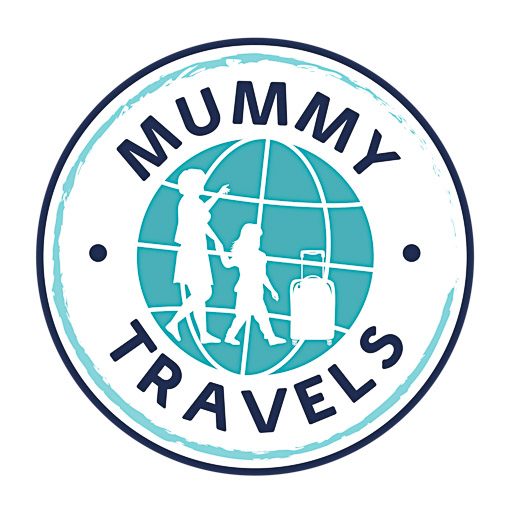
MUMMYTRAVELS
Can you really keep travelling with a child in tow?
Subscribe to be the first to get new family travel inspiration
Tips for London Underground with toddlers
If you don’t use the tube regularly, it can feel overwhelming to start planning journeys – and that goes double if you’re travelling on London Underground with toddlers, babies and preschoolers.

contains affiliate links *
There’s no getting away from the fact that it’s not always easy: London’s tube network is over 150 years old, which means some are served only by stairs rather than escalators and lifts can be few and far between.
But millions of people travel on London Underground every day, including a lot of families – and I’ve survived plenty of tube journeys with my daughter, from her earliest days out in a buggy to trips on the London Underground as a toddler and a preschooler.
For ideas of the best things to do in London with toddlers and preschoolers , check out my top picks


Young kids travel free
First, the good news. Children under 11 travel free on all Tfl services, including bus, tube, overground and DLR. Even if you’re changing onto some of the London commuter rail routes, under-fives don’t need to pay for tickets.
You’ll also find wider, accessible gates to the sides when you’re entering and exiting most major stations, which have plenty of room to get a buggy through.
For smaller tube stations, there’s usually a luggage gate which staff can open for you – if there are no staff around, they’re usually left open.
Always remember to touch in and touch out on the yellow pad, even if the gates are open. On buses, you only need to touch the pad as you get on.
The simplest option for adults is to use contactless payments on a credit or debit card – simply swipe it in the same way as an Oyster card, and you’ll be charged the same fare, which is capped at a daily maximum. You can also use Google Pay and Apple Pay on your phone in the same way.
If you can’t use a contactless card, an Oyster card gets the cheapest fares and a daily capped rate. There is a £7 charge and you’ll need to add a minimum of £10 pay as you go credit.
For more tips if you’re using the London Underground with kids aged 5+ as well as babies, toddlers and preschoolers, check out this post

Download Citymapper
One of my top tips for navigating the London Underground with toddlers – with kids of any age, in fact! – is to download the Citymapper app .
As well as showing you the different routes you can take, using bus, tube, overground and DLR, you can also filter it to show you step-free journeys.
There’s also the option to select bus routes only, and compare different routes: if you’re travelling with a buggy or a wriggly toddler, you might well decide that a slower journey is better than having to change along the way.
It even includes the new Elizabeth Line, with notes on when the different sections of line open.
A list of journeys with step-free access , as well as lifts out of service, is available from the Tfl site too.
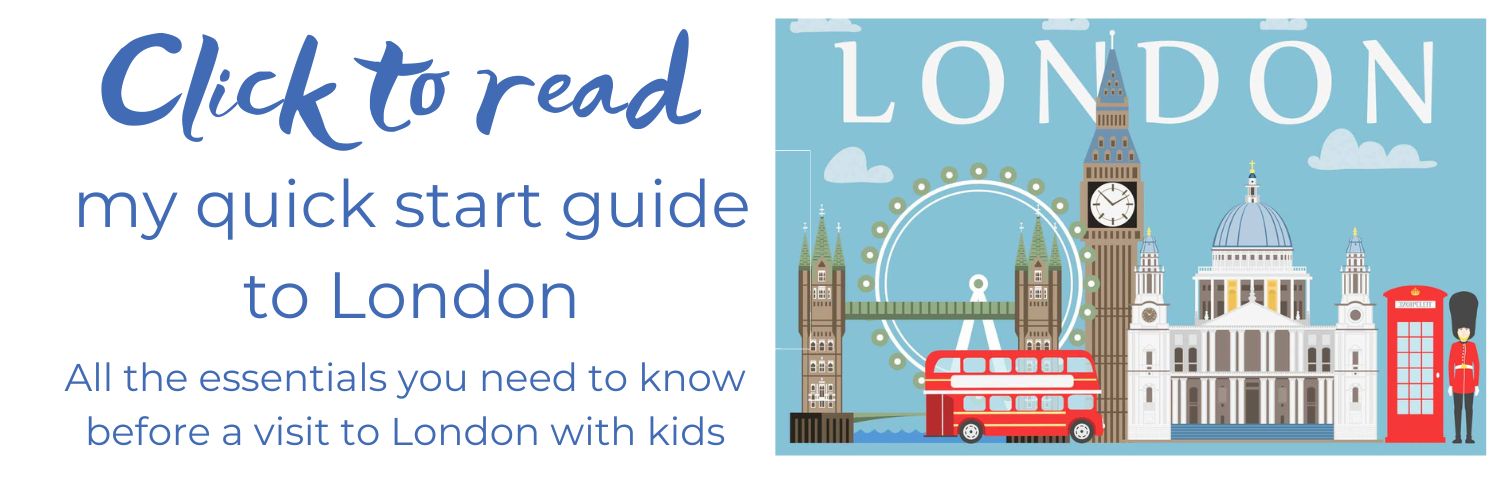
Pack a lightweight buggy
If you’re travelling with a baby, a carrier is often one of the easiest ways to get around London if you’re taking public transport – but once your kids are toddler age (and size), a buggy is usually the only option.
While people in London aren’t as unhelpful as the stereotype (although sadly not as helpful as my experiences on the Paris Metro), it’s best to be prepared to carry it or ease it gently up and down the steps solo.
I used a lightweight Maclaren stroller or check out options like the Babyzen Yoyo which is small and light enough to take on planes as hand luggage, so a good option if you’re after something easy to carry.
Taking a pushchair on escalators isn’t recommended, so if that’s the only option, it’s safer to find a quieter corner, fold it for the escalator and carry/hold your toddler.
On buses, there is limited space for pushchairs – there’s one wheelchair space, which can fit one or two unfolded buggies if not being used (wheelchair users get priority), so you may need to fold your buggy to get on. It’s up to the bus driver to decide though.
If you have a double buggy, check with the driver first but you can usually board through the wider rear doors.

Try alternative transport
While you don’t have to avoid the tube entirely, you don’t need to rely on it for all journeys either.
If you’re only travelling a short way, it’s usually far easier to catch a bus than to head down into the London Underground with a toddler for a couple of stops.
And while the tube map is an iconic design, it’s not always the most helpful guide in terms of London’s geography – sometimes it’s faster simply to walk if two stations are closer than they look.
Check Google Maps as well as Citymapper as it also points out nearby bus stops, while this helpful map showing walking distances between stations .
If you’re worn out after a day exploring, black cabs can also take prams and pushchairs, so you don’t need to worry about having a car seat. You can book with apps like Gett if you can’t see one to flag down.
And while you’re unlikely to make all your journeys on the river boats, you can also take buggies on the Uber Boat by Thames Clippers water bus – it’s worth knowing that kids aged 5-15 pay a half fare on the boat, but under fives still travel free.
Check out the best boat trips in London with kids if you’re looking to travel along the river
Avoid the busy times
Sometimes easier said than done, especially if you’re visiting London in school holidays or for a major event, but if you can avoid peak times, do.
Travelling after 9.30am and before 4.30pm cuts out the worst of the rush hour. If you can’t avoid it entirely, heading to the end of the platform can often mean quieter carriages as well.
While passenger numbers are still lower than before the pandemic, in April 2022 they were back to more than 80% of the 2020 rates, so you can’t count on quiet carriages unfortunately.
Don’t count on toilets in stations
There’s nothing worse after manoeuvring the buggy down to the platform than a little voice saying, mum, I need the toilet…
If you’re travelling with a potty-trained preschooler, there are some tube stations with toilets – some of which also include baby changing. Check out the Tfl map to plan any toilet stops.
You may need to pay a small charge, and they may not be available however. The Flush app is another helpful one to download, showing the closest toilets to your location.

Make the journey more exciting
Let’s face it, sitting on the tube isn’t necessarily the most thrilling experience whether you’re 2 or 42 – although for some toddlers and preschoolers, anything relating to trains and buses is automatically a huge treat.
If not and you want to entertain them for a short journey (rather than constantly grabbing a book or toy from a bag), pick up a map of the tube network.
Preschoolers can try counting the stations on the tube line or checking the colours of the different lines. Or there’s always I-Spy – the old-fashioned version, or even a pocket-sized I-Spy London Transport book.
It goes without saying to take extra care on the London Underground with toddlers.
And that’s not just staying behind the yellow lines at stations, and not attempting to dive onto a train as the doors are beeping, but keeping a tight hold on escalators (some of which can be very steep) or as trains and buses jerk away from stops and brake abruptly.
But with so much of London to discover, there’s no reason to wait until you’ve left the toddler and preschooler years behind.
Disclosure: This post contains affiliate links – any purchases you make are unaffected but I may receive a small commission . All opinions on using the London Underground with toddlers are my own
Images: To The Trains copyright MummyTravels, all others courtesy of Depositphotos
Award-winning family travel blogger and mum to the mini traveller, aka Minnie. Together we've visited Europe, America, the Caribbean, Africa and Asia, tried a cruise and a road trip, and survived countless long-haul trips. London (UK) based. Serious beach habit.
Leave a Reply Cancel reply
Your email address will not be published. Required fields are marked *
This site uses Akismet to reduce spam. Learn how your comment data is processed .
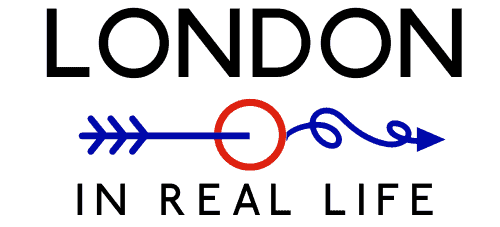
Easy Illustrated Step-by-Step Guide: How to Use the London Underground for the First Time
If you have high anxiety like me, you’re probably wondering how to use the London underground for the first time.
The London tube system is massive and complex – where do you even begin?
For anxious travelers like us, navigating a huge city like London can be overwhelming. If you’re worried about how to take the tube, you’re not alone.
I’m going to explain how to use the London tube: from maps to tickets to stepping on the train, I’ve got you covered.

Here’s my step-by-step guide for how to use the tube for the first time.
Let’s start with the basics.
📖 London Underground Guide to Words and Phrases
Londoners use many of these common words and phrases when referring to the Underground.
Let’s look at the most common ones you will encounter and may need to understand.

- London Underground (or “The Underground”) : The official name of the public rapid transit system of London.
- Tube or “The Tube”: Nickname that has become the unofficial name for the London Underground. You can say either “tube” or “underground.”
- Train: The trains that run within the underground network. Not to be confused with National Rail, which is the above-ground trains that run all over the UK. People usually say “I’m taking the tube” when they’re talking about the Underground, and “I’m taking the train” when making a longer journey out of London.
- Carriage: the individual train cars that you board on the underground. A series of carriages make up the train.
- Tap In/Tap Out: Touching your Oyster card or contactless payment card on the yellow card readers at the start and end of your journey to pay for your fare.
- Mind the Gap: A famous audible and visual warning to remind passengers to be cautious about the gap between the train door and the station platform.
- Oyster Card: A reusable, credit card-sized smartcard used to pay for journeys on public transport in London. It can be topped up with credit.
- Top Up: To add credit to your Oyster Card ( put more money on it either in the app or at a machine inside the station).
- Platform: The area in a station where passengers wait for the train.
- Lines: These refer to the different tube lines on the London Underground, each identified by its own name and color on the map. ( you might say “I’m taking the Piccadilly line to Covent Garden”) .
- Zone 1, Zone 2, etc.: The tube network is divided into fare zones (1-9) with Zone 1 in central London and higher numbers on the outskirts. Fares vary by how many zones you travel through.
Now that you know all the terms I’ll use here, let’s get into how to use the Underground!
🧭 How to Use the London Tube Map

The London tube map looks confusing, but it’s actually pretty simple. Every tube line is color coded, and every station is mapped with what lines connect through it.
If you’re visiting London, you don’t need to study or memorize the tube map.
Most travelers coming to London will have a mapping app (I like Citymapper the best ) that can tell you exactly where you are and where you’re going.
If you don’t have a phone or mobile data in London (I highly recommend you do!), then you can use the tube map to get around.
Alternatively, you can download maps within your navigation app when you’re on wifi, then use them when you’re out and about.
🧭 London’s Tube Lines Are Color-Coded

Each London Underground line has its own color so the routes are easily identifiable.
Follow your color through the station and onto the train. It’s that easy! (I’ll show you some photos from inside of a tube station and how to find the correct platform down below).
Just don’t call London’s tube lines “the blue line” or “the yellow line” – they are only referred to by their names.
🧭 Riding the Tube in London: Zones & Fares

The Underground’s zone and fare system is a bit more complicated, but for visitors, you don’t need to understand the whole thing.
The basic system is this: the transport zones categorizes areas of the London Underground by their proximity to Central London.
Zone 1 is the most central, Zone 2 is a bit further out, Zone 3 is even further out, etc.
Here’s what you need to know as a visitor about zones :
- The further out from Central London you go – the more zones you travel through – the more you pay in tube fare.
Here’s what you need to know as a visitor about fares :
- For each zone, there is a daily and weekly fare cap.
- If you’re using pay-as-you-go ( simply tapping in with a contactless or oyster card ), you’ll never pay more than the cap for the farthest zone you traveled to.
- The most central zones are cheapest, and the furthest zones are the most expensive, since you’re traveling farther.
- There are peak and off-peak fares, but these don’t affect the fare cap.
- You can use TFL’s Fare Finder to calculate a fare, or if you use Citymapper , it will tell you the price right in the app.
💳 How to Pay for Your Tube Ticket

Visitors to London can get overwhelmed by the amount of tube ticket varieties: daily or weekly Travelcards, Visitor Oyster Cards, single journey tickets, and more. It’s unnecessarily complicated.
✅ See my full guide to Oyster Card tourist options HERE. ✅
For MOST London visitors, you should just use Pay as You Go. That means simply tapping in and out with any any form of contactless payment .
Simply tap your phone or contactless card on the big yellow circle and the gate will open.
There’s generally no need to buy a ticket, an Oyster Card, or a Travelcard. These options are usually more expensive for visitors.
Tap again on the way out, and you’ll be charged the correct fare! When you use pay-as-you-go, you will automatically be capped at the daily maximum, no matter how many rides you take.
Make sure you have a different contactless payment method for each member of your party to avoid being drastically overcharged.
💳 Paying for the Tube When Traveling with Family or Groups
Don’t have enough contactless payment methods for everyone?
You can double the amount of contactless methods simply by adding your debit or credit card to Apple Pay, Google Pay, or any digital wallet – those are counted as separate payment methods from the physical credit or debit card.
Keep in mind children under 11 travel free and don’t need any type of payment method, as explained in detail below.
For example:
- Traveler #1: Uses debit card A to tap in and out.
- Traveler #2: Uses Apple Pay connected to debit card A to tap in and out.
- Traveler #3: Uses physical credit card B to tap in and out.
- Traveler #4: Uses Apple Pay connected to credit card B to tap in and out.
💳 Do I Need an Oyster Card?
No. Unless you don’t have enough different contactless payment methods for everyone in your group, you don’t need to buy an Oyster card or any kind of travel pass or ticket.
Oyster Cards cost £7 for the card itself, along with however much money you want to load onto them. You can avoid this hassle by just using the contactless payment methods you already have.
However, if you’re traveling with children between 11-18, it may be smart to buy them an Oyster Card and have TFL staff apply the child discount to that card. Children’s fares are cheaper, but only using Oyster, and under 11’s travel free .
👩👩👧👦 How to Take the Tube with Kids

Riding the tube with kids under 11 is easy!
Locate the largest ticket barriers marked with blue signage.
Tap in with your contactless payment method, and the gate will open.
Your child or children walk through the barrier with you at the same time.
Do the same thing when you tap out at your destination. Done!
🚇 London Underground Guide: Exactly How to Ride the Tube for the First Time
Now that you know all about the maps, colors and payment methods, let’s go through exactly how to ride the London tube.
Have your mapping app and your contactless payment method ready for the journey.
✅ Step 1: Plan Your Journey

Riding the tube in London is easiest when you use a navigation app to guide you.
My favorite London navigation app is Citymapper , but you can also use Google Maps.
Plug in your destination, and the app will tell you which tube line you need and which station to catch the train at.
Make your way to the station you need for your journey.
Look out for travel alerts on your journey: an alert icon will come up if there are delays, strikes, or stoppages.
✅ How to Use the Tube for the First Time Step 2: What to do at the Station

Once you reach the station, you will see a line of ticket barriers. If you have never gone through one before, just stand out of the way and watch what others do.
When you approach the gate, have your contactless payment or Oyster Card ready.
Tap it on the big yellow circle and the gate will open. The little electronic display will tell you how much the fare is and the balance left on your Oyster Card (if you’re using one).
Go through the gate and look for signs to the line that you need.
✅ How to Take the Tube Step 3: Finding Your Train

In your navigation app, find out which train line you need. They are all color coded : follow signs to the correct color.
Going down the escalators, stand on the right and walk on the left.
DO NOT stand still on the left hand side of the escalators; this will block people who are going down the escalator in a hurry.

At the bottom of the escalators, there will be more signs.
Look on your app to find out which direction your train is going (Northbound, Southbound, Eastbound, or Westbound).
Locate the direction you need and follow the signs.
At some point you will reach a sign that has all of the stops that your train is going to. Make sure your stop is on that sign, and if it is, you can be sure that you’re taking the correct train !
✅ Riding the Tube in London Step 4: On the Platform

Wait on the platform (well behind the yellow line) until your train arrives. There will be an electronic reader board that tells you when the next trains are arriving.
When the reader board flashes, that means the train is approaching. Stand back.
The doors will open, and passengers will get off. When no one else gets off, you can board the train.
As the train approaches, it may be loud coming through the tunnel and you may feel a big gust of wind. There may also be a squeak as the brakes engage.
You will hear and read the common warning “mind the gap”: this means to be aware of the gap between the train and the platform. Some gaps are big, and some you won’t notice at all.
✅ How to Use the Tube for the First Time Step 5: Finding a Seat

You can sit in any open seat, including seats for disabled, elderly, or pregnant passengers, as long as no one else needs the seat.
If someone boards the train who needs that seat, make sure to get up and offer it to them.
If the train is very crowded, like during morning and evening rush hours, you may need to stand and hold on to a railing.
✅ London Underground Guide Step 6: Getting off the Train

Stops are announced both over the speaker and on the screen.
You can also look out the windows when you’re entering the station to see which station it is on the roundel logos (the red/blue circle logo that signifies the London Underground).
Once you’re at the correct stop and get off the train, look at the signage.
If it’s your destination station, look for the exit signs.

Once you step off the train, pull over out of the way to look at the signs directing you to where you need to go.
If the station is very crowded, just wait a minute by the wall. The passengers will clear out and you can more easily find the signs you need.
If you’re transferring to another line, look for the signage to that line. Transferring may involve more escalators, lifts, and walking through the station.
Just keep following the signs to the line you need, then repeat the same as above when you found your first train.
✅ Riding the Tube in London Step 7: Exiting the Station

If you’re using Citymapper , it will tell you which station exit is best (if the station is large it may have multiple exits).

Follow the exit signs, and tap out with the same card you used to tap in. Make sure you use the exact same card so that the fees will be charged correctly.
If from here you want to connect to a bus, read my guide on how to catch a London bus.
Etiquette for Riding the Tube in London

There are lots of subtle courtesies Londoners use when riding the tube, but as a visitor, these ones are the most important for you to follow.
- Have your contactless card ready at the barriers. Don’t block the barriers while fumbling to take out your card, especially if the station is very busy.
- On escalators, stand on the right and walk on the left. Do not block the whole escalator – many, many people walk on the escalators (on the left) instead of standing still.
- Don’t be oblivious to someone who needs a seat. You can sit in the priority seats if no one needs it, but if anyone enters the carriage who needs it more than you do, give them your seat.
How to Use the London Underground for the First Time: Final Tips
Using the London Underground for the first time might seem daunting, but with this step-by-step guide, you can confidently explore the city.
It’s absolutely the easiest, fastest, and cheapest way to get around in London.
Simply plan your journey in advance, use contactless payment, and follow the signs within the stations. If you get lost, ask any Underground employee for help!
Remember, London’s Underground is a safe, efficient, and exciting way to see the city, so take a deep breath, embrace the adventure, and enjoy your journey!
More on Navigating London
The Best Oyster Card Tourist Options to Save Money
How to Catch a Bus in London for the First Time
Where Can I Charge my Phone in London? Local’s Ultimate Guide (2024)
What NOT to do in London: The Truth About these 15 Tiring Tourist Traps
The Ultimate London Underground Quiz: Can you Pass?
How to Travel in London During a Tube or Rail Strike
The Best Navigation App for London to Download Now
How to Use Google Maps in London
The Best Free Viewpoints in London
How to Use the London Tube: FAQ
How do i use the london tube ticket machine.
The ticket machines in every station are very easy to use. First select your language, then follow the prompts. If you need help, TFL staff are always happy to assist you.
Does the Tube always come from the left?
For the most part, yes, but not always. Tube trains run on the left hand track (tracks are like a road underground; there are left tracks and right tracks) so they generally enter the station from your left when you are standing on the platform. But this isn’t true for all stations.
Do I need a card for the tube?
Not necessarily. You just need some type of contactless payment method.
Do I need an account to use contactless on the tube?
No. Just use your contactless card or digital wallet on your phone to tap in and out. There’s no need to register an account!
Does the tube take cash?
No. The London Underground only uses contactless payment methods at the ticket barriers.
You CAN use cash to purchase an Oyster Card at some ticket machines inside stations, but not all ticket machines accept cash.
Is it cheaper to use Oyster card or contactless?
The rate you pay for your journey will be the same whether you use Oyster or contactless. But if you buy a physical Oyster Card, it costs £7 for the card, not including any money you put on it.
If you have a contactless card for each member of your party, there is no need to purchase any Oyster Cards.
Is the Tube faster than the train?
The tube and train are two different things. The “tube” refers to the London Underground network. The “train” in London is referring to National Rail, which are trains that run to and from London.
You will rarely have a journey where you can take either the tube or the train to the same destination; it’s usually one or the other.
Can you just use a debit card on Underground?
Yes, as long as it’s contactless. You’ll know if you have a contactless card by the chip on the front of the card.
If your card does not have a chip, it is not contactless and you will need to either set up a digital wallet (like Apple Pay or Google Wallet) to tap in and out of the tube, or purchase an Oyster Card.
What is the cheapest way to use the Tube in London?
Fares vary by zone: which zone you start in and how many zones you travel through. There is no “cheapest” way for a single journey: the cheapest way is simply to use a contactless card to tap in and out (always use the same card).
Never buy a travel card or a single journey ticket at the ticket machines. These are rip offs.
What to do if you forget to tap in on the tube?
It’s unlikely that you’d forget; you won’t make it through the ticket barriers unless you tap in and out.
What is the cost of a day Travelcard in London?
Travelcards start at £15.20. The daily fare cap is usually less than this , so don’t buy a travelcard.
Do all tube stations have ticket machines?
Yes, every tube station in London has a ticket machine. Rarely they will be out of order and you will need to find one somewhere else.
What happens if I touch in with one contactless card and touch out with another on the same journey?
You’ll be charged for two incomplete journeys. Always tap in and out with the same card.
Can 2 people use the same contactless card on the tube?
If you each have different physical cards on the same bank or credit account, that’s fine: you have two different cards. But you can’t tap in with the card then hand it to the person behind you to tap in, too. That would really mess up the prices and you’d be overcharged.
How do I pay contactless without a card?
If you don’t have your physical card with you, you can set up a digital wallet like Apple Pay or Google Wallet. If you don’t have a credit or debit card at all, purchase an Oyster Card.
Can you bring food on the tube?
Yes, but try not to bring really smelly foods (a tunafish sandwich, for example) or messy foods.
Do I need to register my contactless card to use on underground? Do I need to register my debit card for London Underground?
No, just tap in and out. No need to register for anything.
Can I just tap my card on the tube?
Yes! If it’s a contactless card, just tap in and out with the same card.
Can I charge my phone on the London Underground?
The Elizabeth Line is currently the only line that offers charging ports on trains, but many stations offer charging stations and battery rentals.
Similar Posts

Easy & Essential London 2 Day Itinerary: See it All, Fast
Londoner reveals the easiest London 2 day itinerary to make the most of your time.

Super Simple London Neighborhood Guide: Where’s Best for You?
An easy, free London neighborhood guide for you to decide where to stay or where to live.

67+ Easy & Free Things to do in London for Families Right Now
London is expensive enough. If you’re in London with kids, it’s even more expensive (trust me,…

Expert’s Easy Itinerary for 3 Days in London
Here’s a Londoner’s easy itinerary for 3 days in London. See the best bits, grouped together for easy travel.

9 Easy Ways to Get Cheap Train Tickets for London
Cheap train tickets for London sometimes seem like a myth. But there are ways to save! Here are 9 ways to get cheap train tickets to London.

How Big is London? What Tourists Need to Know
How big is London, really? Here’s everything tourists need to know to understand the massive size of London.
The ultimate guide to visiting London with kids

Mar 15, 2024 • 9 min read
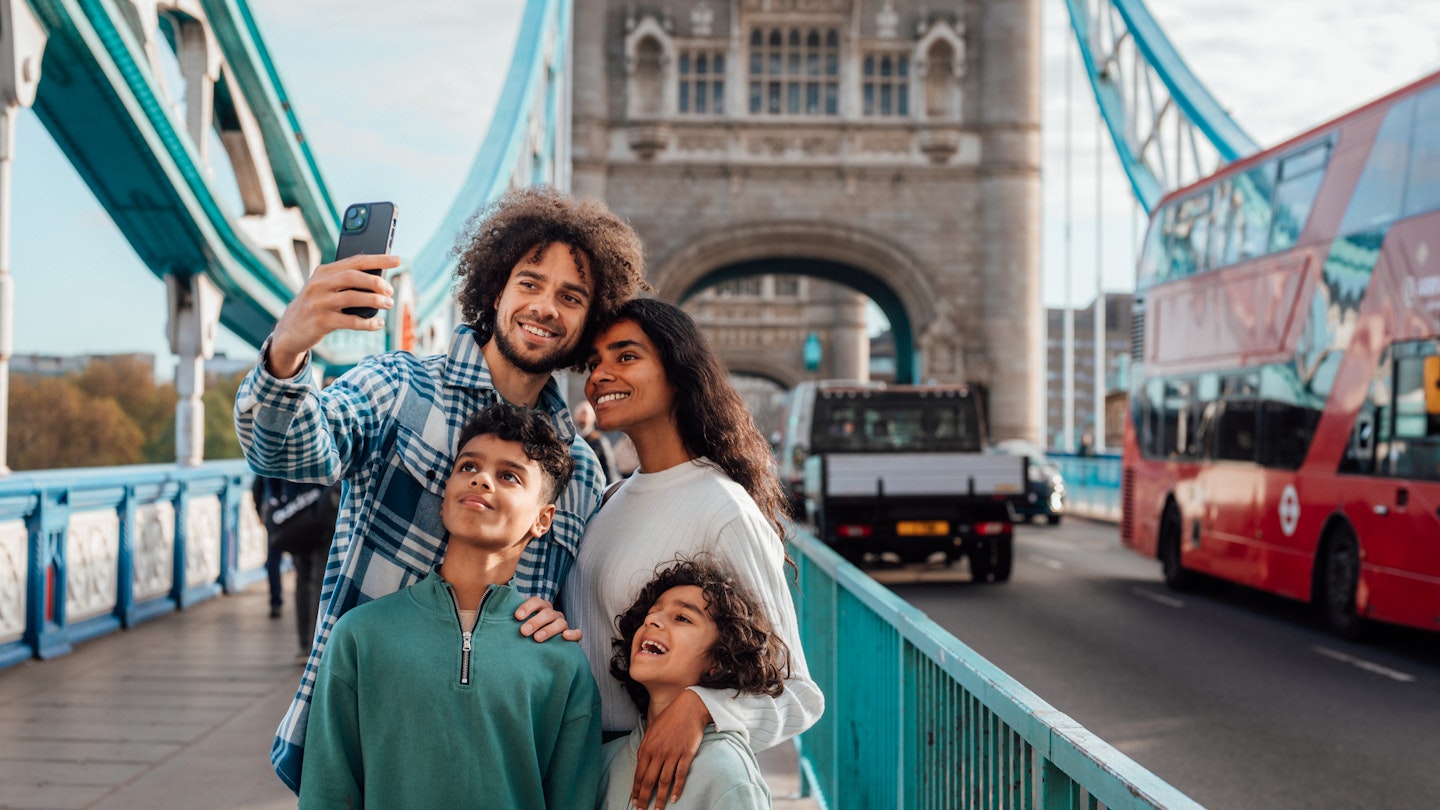
Make the most of your family holiday with this guide to travel in London with kids © Ahmani Vidal / Getty Images
London is an expensive city to visit and one that’s large and sometimes difficult to navigate. But, it's also packed with fascinating historic sights, bags of culture, world-class museums, parks and wide-open spaces with excellent playgrounds, and plenty of things to occupy children of all ages.
The permanent collections at many museums and art galleries are free to enter (donations welcome) and they generally offer some kind of audio guide or experience aimed specifically at families. For older children, London’s Harry Potter connections tend to be popular, and with so many different exhibitions and theater performances, there is something to align with the passions of every tween and teen.
Here's everything you need to know about visiting the English capital with tots in tow.
Is London good for kids?
In a word, yes! Londoners may not seem particularly kid-friendly at first, but if you need a hand carrying a stroller up an unexpected flight of stairs, someone will almost always stop to lend a hand.
While central London can feel hectic during peak hour, with workers rushing to and from work (or in the height of summer's peak visitor season when popular attractions will be crowded) London does have plenty of pockets of serenity. There are parks and gardens throughout the city to take a break with kids. Get to popular sights early in the day (the earlier the better) to avoid queues, and note that some sight require pre-booking even if they're free. If you're looking for somewhere to eat, loads of major chain restaurants (and pubs) offer good-value children's menus with a drink and dessert included.
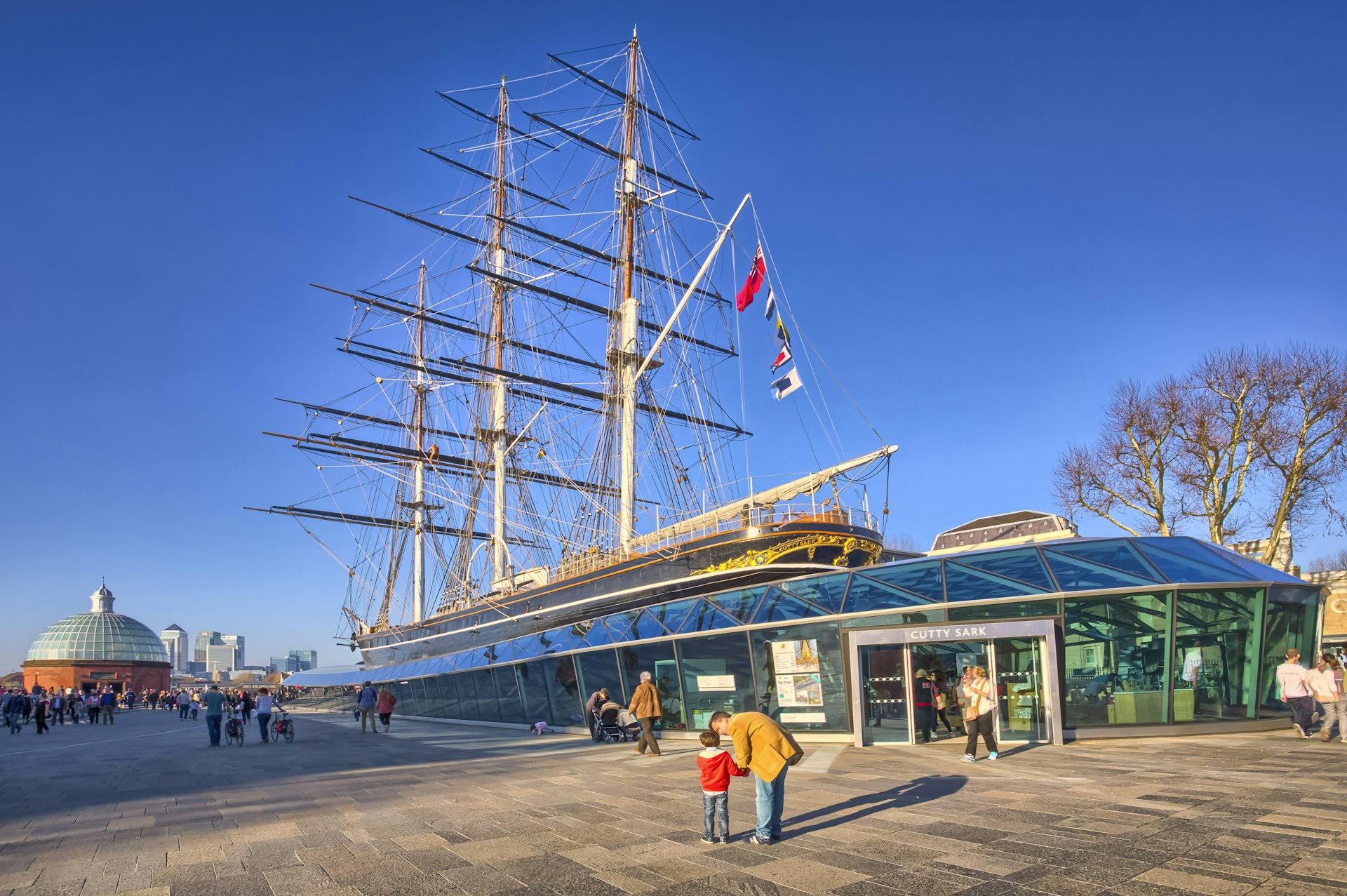
Where is best in London for kids
London’s South Bank offers endless family entertainment. In the summer months bring a change of clothes, as your kids are likely to make a beeline for Southbank Centre 's fountains. The London Eye provides high-up views over the river to Big Ben and beyond, and the Sea Life London Aquarium , with a shark tunnel and penguin area, is particularly popular with younger kids. Shrek’s Adventure is a 90-minute theme park experience centered around the fairy tales in the Shrek movies. If you have teens who enjoy being scared, they will get a kick out of the creative presentation of gory historical events at the London Dungeon .
Heading further east, learn about the role HMS Belfast played in WWII while climbing down below the river’s water level and shuffling along tiny corridors (not easily done with toddlers or babies in prams). When you get hungry, head to Borough Market to discover a wealth of food options from kid-friendly fish 'n' chips and ice cream to paella and oysters.
Greenwich in southeast London is a small area with good options for kids of all ages. It can be reached by train or the DLR, but it’s much more fun to take the Thames Clipper from central London to Greenwich Pier. Younger kids are likely to love the massive adventure playground in Greenwich Park, with sand, water play, and plenty to climb on.
Learn what life was like on board a 19th-century tea clipper at the Cutty Sark . For even more naval experiences, head to the National Maritime Museum (there’s a great gallery aimed at children aged seven and under called Ahoy!). The Royal Observatory on the hill offers a chance for older kids to explore space and time. Grab lunch at a stall in the food market , or head for one of the many chain restaurants.

Best things to do in London with babies and toddlers
Tour london's top parks and playgrounds.
London is a surprisingly green city, with a lot of large open spaces . Regent’s Park is the biggest and most elaborate of central London’s many Royal Parks. Among its many attractions are London Zoo, Regent’s Canal , an ornamental lake, and grass pitches where locals meet to play sports. Rent a pedal boat on the Serpentine in Hyde Park , and run free in one of London’s best playgrounds , Diana, Princess of Wales Memorial Playground, in nearby Kensington Gardens .
Here kids will be delighted by the large pirate ship, waterplay, and sandpits. A wander through St James’s Park is worthwhile for its lovely gardens and great views of London icons, such as the London Eye and Buckingham Palace .
Come face-to-face with a dino at the Natural History Museum
The Natural History Museum is a colossal and magnificent building housing 80 million specimens from the natural world, with displays on everything from the human body to rare fossils and gems. Hintze Hall, at the center of the museum, is home to an awe-inspiring blue whale skeleton that hangs from the ceiling. This is also where pre-schoolers seek out Andy's Clock, the magical time-traveling device from CBeebies TV show Andy's Prehistoric Adventures .
The Dinosaur Gallery is packed with info and skeletons of many different dinosaurs and is a big hit with kids. The absolute highlight here is the animatronic T-rex that swings its colossal tail and flexes its jaws while roaring at the gathered crowd (beware: it can be genuinely frightening for little people). The museum is also home to the ever-popular Wildlife Photographer of the Year exhibit, showcasing the fragile natural beauty of our planet through 100 photos.
Learn about conservation at London Zoo
Regent’s Park is home to the oldest zoo in the world , dating from 1828. The emphasis nowadays is firmly on conservation, breeding and education, with fewer animals and bigger enclosures. Highlights include Land of the Lions, Gorilla Kingdom, Night Life, Penguin Beach and the walk-through In with the Lemurs. There are regular feeding sessions and talks, various experiences are available, such as Keeper for a Day, and you can even spend the night in one of nine Gir Lion Lodge cabins.

Best things to do in London with kids
Have a hands-on experience in the science museum's best galleries.
The Science Museum in Kensington brings themes such as space, flight and climate change to life with a series of hands-on exhibits and virtual displays. Get close to a space module, track the history of aviation, and learn about the importance of ice in the Antarctic. For younger children aged three to six, head to The Garden in the basement. This free interactive gallery allows for construction with blocks and cranes, and sensory exploration with sound, touch, and water play.
Those aged six and above will be enthralled by the liquids, magnets, smoke and light that they can play with in the different zones of Wonderlab on the top floor. Science Museum "Explainers" will merrily chat with youngsters about anything from how a bubble is formed to how planets move around in the solar system, as well as running live demos and experiments showing science in action.
Go to family-friendly theater shows
Big productions aimed at families include Matilda the Musical at Cambridge Theatre, Harry Potter and the Cursed Child at Palace Theatre, and Disney’s The Lion King at Lyceum Theatre. Tickets need to be booked well in advance, especially if you're on a budget .
It’s often easier to get tickets to smaller productions at theaters away from the West End. Consider Unicorn Theatre near the South Bank or Little Angel Theatre in Islington, where all performances are aimed at youngsters. The Southbank Centre also runs family performances, particularly during local school holidays.
See wax creations of your fave celebs at Madame Tussauds
Madame Tussauds , packed with waxwork likenesses of all kinds of famous people – from royals to sports personalities – may be kitschy and pricey, but it makes for a fun-filled day. Music-loving teens can grab photo ops with top current singers, including Lady Gaga, Beyoncé, Ed Sheeran, Rihanna, and One Direction, and even legends such as Bob Marley and Freddie Mercury. Young movie fans may want to visit the heroes and villains of Star Wars , stand with Katniss Everdeen, or see E.T. up close. Book online in advance for the best rates, and then look out for your favorite celebrity.
The V&A Museum of Childhood is a toy-filled wonderland
Housed in a purpose-built Victorian-era building, this branch of the Victoria & Albert Museum is aimed at both kids (with play areas, interactive exhibits and dressing-up boxes) and nostalgic grown-ups who come to admire the antique toys. From teddies, doll’s houses and dolls to Meccano, Lego and computer games, it’s a wonderful toy-cupboard trip down memory lane. It's free to enter and has recently undergone a major refurbishment to make it an even more exciting location that's focused entirely on fun for young adventurers.
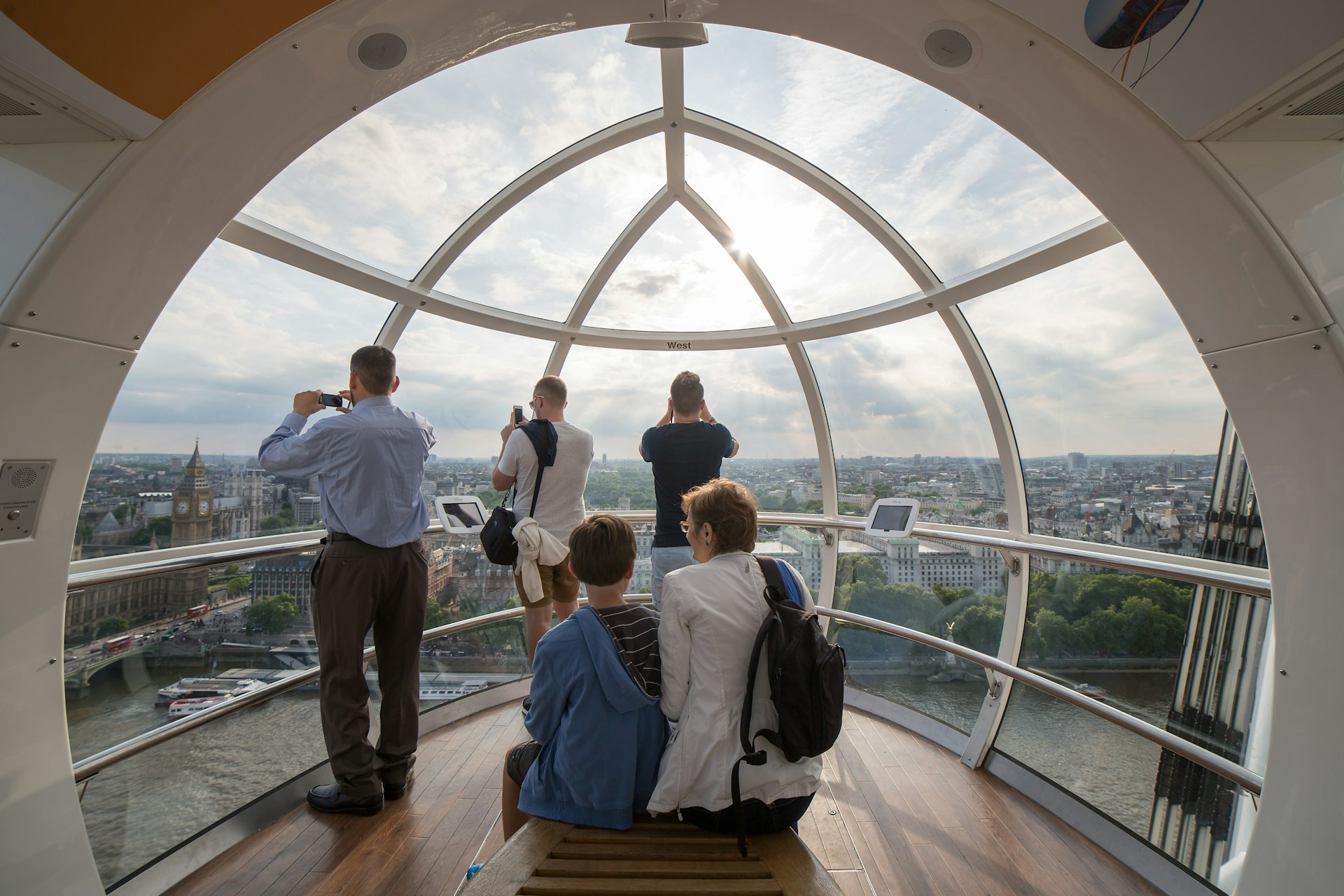
Best things to do in London with tweens and teenagers
Follow a trail to see the treasures of the british museum.
The displays at the British Museum spark the imaginations of visitors of all ages, with displays of Egyptian mummies, buried treasures from Anglo-Saxon times, and Samurai armor. There are various worksheets, activities and trails designed specifically for younger visitors covering different themes within the museum. You can follow the " Twelve objects to see with children" trail with tweenagers for a whistle-stop tour of the highlights of the museum, or perhaps the "One hour at the museum" trail before self-declared teenage "boredom" sets in.
Take a boat ride along the Thames
At some point it's really worth taking a cruise along the Thames to spot some of London’s icons. If your kids love a thrill, Thames Rockets has rigid inflatable boats that zip along the river and back from the London Eye Pier (go prepared to get wet). For a more leisurely approach to sightseeing, take the Uber Boat by Thames Clipper , a riverboat commuter service stopping at piers throughout the city from Woolwich down to Putney.
Admire the Houses of Parliament , speed under the Millennium Bridge (destroyed by Death Eaters in the opening scenes of Harry Potter and the Half-Blood Prince ) and catch a glimpse of St Paul’s Cathedral . As you pass the Tower of London , look for the Traitors’ Gate at river level where prisoners entered the Tower, before whizzing underneath the impressive Victorian Tower Bridge .
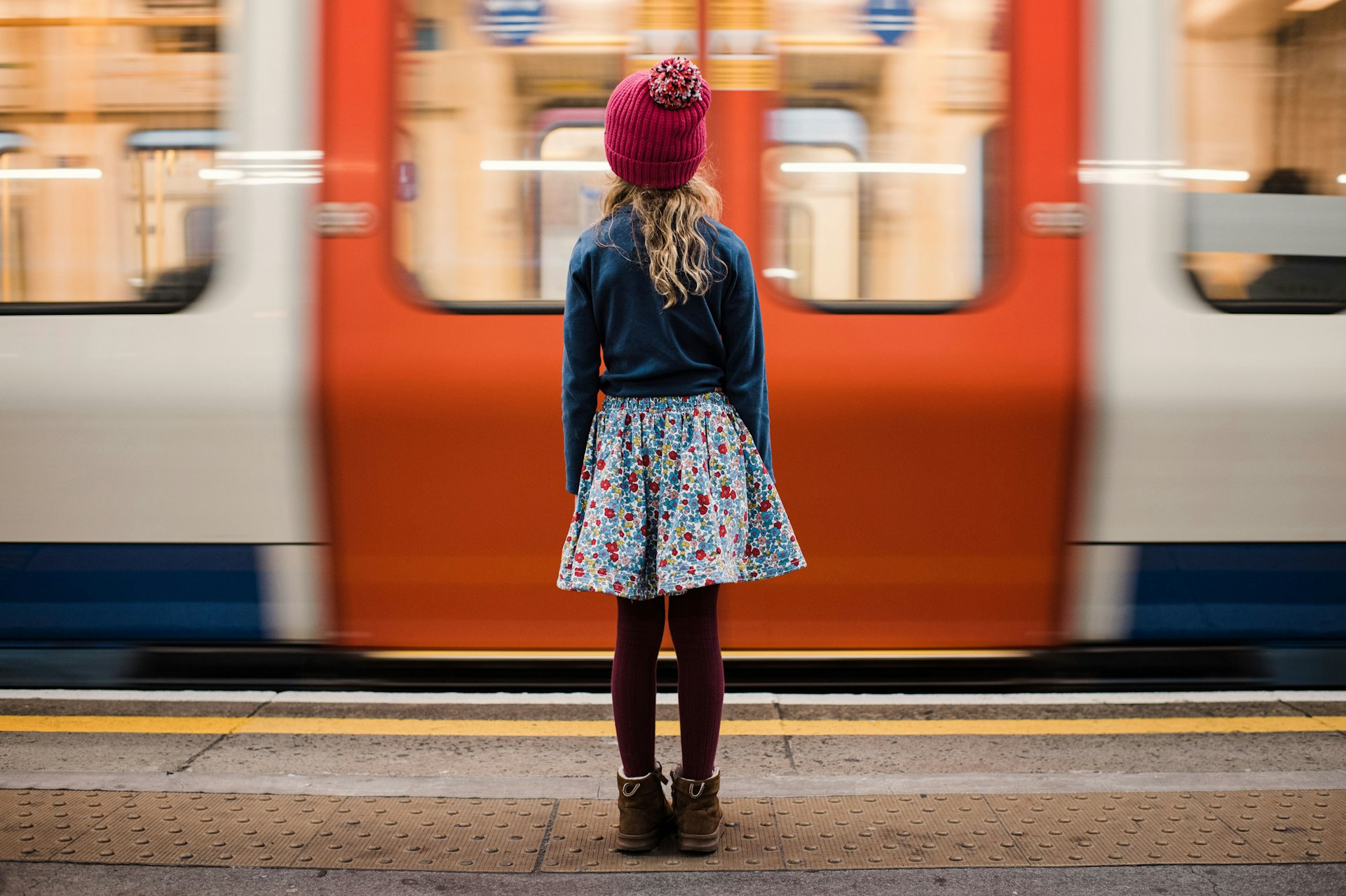
Planning tips
As with any large city, dragging small kids around in London can be exhausting for everyone. Staying realistic about how much you can see in a day and being flexible with your schedule is the key to keeping everyone happy.
Unfortunately, London is not particularly easy to navigate with a stroller or for anyone with accessibility needs. Even Tube stations with step-free access often have a big gap between the train and the platform, and you can end up walking a long way through the underground network before reaching the platform you need.
Buses are often a better options for getting around central London at least. Better still, divide your visit into neighborhoods and walk between sites to minimize your time fighting the often frustrating transport system.
Note: children under 11 travel for free with a fare-paying adult. You can get a discounted Visitor Oyster cards for children aged 12 to 16 by asking a staff member to add a "Young Visitor" discount to your Oyster card at a London tube or train station. Over the age of 16, your child will be paying the adult rate.
This article was first published March 2015 and updated March 2024
Explore related stories

Family Travel
Sep 8, 2023 • 8 min read
When one writer took a vacation to visit family in the USA, she had no idea how much her life would change.
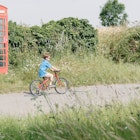
Jul 14, 2023 • 7 min read

Mar 7, 2023 • 7 min read
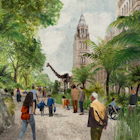
Nov 2, 2020 • 2 min read
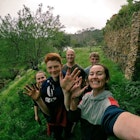
Sep 16, 2020 • 4 min read

Jul 16, 2020 • 5 min read
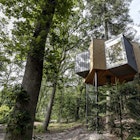
Jul 9, 2020 • 8 min read
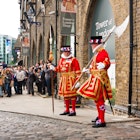
Jun 29, 2020 • 2 min read

Apr 6, 2020 • 4 min read

Mar 10, 2020 • 6 min read

21 Exciting Things to Do in London for Children (2024)
O ne of my favorite destinations for families is London. There are so many wonderful things to do in London for children including beautiful parks, historical sites, family-friendly tourist attractions, and amazing shopping districts.
The majority of the best things to do in London for children can be found in the heart of the city, along the banks of the River Thames. It is easy to get around on foot by hopping on the London Underground. Why not book a guided tour, head to the West End for a show, or enjoy high tea at an iconic London hotel? London is a great place if you’re on a budget, only have a few days , or even if you have a whole week! Below, I’ll share the top kid-friendly attractions in London.
*Disclosure: This post may contain affiliate links, which means we may receive a commission if you click a link and purchase something we have recommended. Please check out our disclosure policy for more details. Thank you for your support!
What Are the Best Things to Do in London for Children?
London is a great place to visit with kids of all ages! I think the most difficult choice is deciding what NOT to do. You just can’t fit it all into one trip, so my advice is to skip the things you don’t want to see and focus on what you and your kids enjoy. Here are my top picks for what to do in London with kids.
1. Visit the Iconic Big Ben and the Houses of Parliament
Visiting Big Ben and the Houses of Parliament is a must for families exploring London. Big Ben, officially called the Elizabeth Tower, is one of the city’s most iconic landmarks.
You can book a tour to climb the 334-step spiral staircase to the top , where you will learn about its history and see the internal mechanisms of the clock tower.
Keep in mind that it’s a little tricky to get tickets to Big Ben unless you book them way in advance, due to ongoing conservation work. If you can plan ahead, it’s worth the visit!
Also, kids have to be 11 years old to enter. If you don’t want to bother, you can still admire Big Ben from the outside and take photos.
Next to Big Ben is the Houses of Parliament, also known as the Palace of Westminster. This stunning building is home to the UK Parliament and is open for guided and self-paced tours. They typically run between an hour and 90 minutes. During that time you will see the historic chambers and learn about Great Britain’s democratic process.
2. Tour the Historic Tower of London
If you’re an Anglophile, you don’t want to miss out on a visit to the Tower of London, where the Crown Jewels are located. The Tower of London is a UNESCO World Heritage Site that boasts 1000 years of history as a fortress, royal palace, and prison.
Book a guided tour of the Tower of London to explore its stunning towers, walk along the walls, and hear stories of its past, including tales of kings, queens, and famous prisoners.
Do you think this stop might be too boring for the kids? It’s definitely not! The guides are hilarious, and the stories of the tower are fascinating. Before entering the Tower, pick up a free Family Trails booklet to keep everyone engaged during your visit.
The centerpiece of your tour will be the Crown Jewels, housed in the Jewel House within the Tower. You will be able to see the crowns, scepters, orbs, swords, and ceremonial robes up close, all adorned with precious gemstones and metals. To this day, they are used by British monarchs during important state occasions and coronations.
3. Don’t miss Tower Bridge
While you’re here, plan a stop at the Tower Bridge. The historic site offers panoramic views of the Thames River and the city skyline.
Tours include the Tower Bridge Exhibition where you can visit the Victorian engine rooms and even walk across the glass-floored walkways!
Want to bring a hilarious version of the Crown Jewels to life before or after your visit? Have the kids read Gangsta Granny by Walliams David.
4. Explore All of London’s Great Museums
London offers a variety of fantastic museums for kids, making it an ideal destination for family trips. The Science Museum in South Kensington is always a hit with younger children. It offers interactive exhibits and special exhibitions that make learning about science engaging and fun.
For natural history enthusiasts, the Natural History Museum is a must-visit, with its dinosaur skeletons and interactive displays.
The British Museum is fascinating and houses treasures like the Rosetta Stone, Egyptian mummies, and interactive exhibits that bring ancient civilizations to life.
The National Maritime Museum and Cutty Sark in Greenwich offer highlights of the region’s maritime history. The London Transport Museum showcases the evolution of transportation.
You can even visit a museum inside a replica pirate ship, The Golden Hinde , that’s perfect for adventurous young kids! London is home to so many family-friendly museums and these are just a few.
Best of all, many are free museums, like the British Museum and the Natural History Museum. If you are trying to save money while traveling, add a few of these to your London itinerary.
5. Head to Buckingham Palace and Watch the Changing of the Guard
Watching the Changing of the Guard is one of the most classic things to do in London for children. This is one of the most popular tourist attractions in London. Arrive early to join the crowds and witness the iconic Changing of the Guard ceremony.
This is where the Queen’s Guard hands over duty to a new set of guards, and it’s fun to experience. It typically takes place every other day, in the morning around 11 AM, depending on the season. You should check the official schedule online for the current dates and times.
The ceremony usually lasts around 45 minutes to an hour. There are many great places to watch the Changing of the Guards, but the tried-and-true spots include the palace gates, the Victoria Memorial, and The Mall.
If you’re visiting during the summer and can get tickets, a tour of Buckingham Palace afterward will round out the whole experience! They’re hard to get but book your tickets early and plan on going after watching the guard ceremony.
6. Go on a Hop-on-Hop-off Bus Tour
If you’re planning a shorter trip to London and you’re looking for the best family activities, I suggest starting with a hop-on-hop-off bus tour. It offers a convenient and flexible way to explore the city. You will visit popular attractions like Westminster Abbey, the Tower of London, and the London Eye, all at your own pace.
There are different hop-on-hop-off tours , each one taking you to a wide range of popular attractions and landmarks in London. If you’re not sure which line you need, you can find bus tour reps at most historical landmarks. They can answer your questions and help you find the route that best suits your interests and schedule.
For a scenic tour, take one of the double-decker bus tours and enjoy the exciting views of London! In about 3 hours, you can do the entire circuit and see many of London’s iconic landmarks.
Hop-on-hop-off tours are perfect for families with kids of all ages because you can pick where you want to get off and then get back on later. If you are heading to London for a quick visit, check out my post for more on what to do in London if you only have one day !
7. Check Out the Sky Garden
Visiting Sky Garden in London for the first time is a must for breathtaking city skyline views. Located atop the Walkie Talkie building (20 Fenchurch), it offers unbelievable views of recognizable landmarks like the Shard, Tower Bridge, and St. Paul’s Cathedral.
At the top, there’s a brasserie, if you can get a table. Best of all, admission is free! You still have to book your reservations in advance , sometimes up to 3 weeks before your visit.
8. Find All the Harry Potter-themed Attractions
Harry Potter fans will have plenty to do with all the different Potter-themed sites in London! Head to Wands and Wizard Exploratorium for a magical tea brewing session complete with picking out your own wand. Or see Harry Potter and the Cursed Child at the Palace Theatre.
Take a walking tour of London’s Harry Potter sites, stopping at King’s Cross Station for a whimsical photo at Platform 9¾. Wander through Leadenhall Market, the real-life Diagon Alley. Then, visit Millennium Bridge, Australia House, and the Reptile House at London Zoo and see if you can talk to serpents, too!
You can also book a guided tour if that’s more your thing.
9. Take a Ride on the London Eye
Riding the London Eye is a great thing to do for the entire family. The London Eye, located on the South Bank of the River Thames, is a giant observation wheel that provides some of the best views of London’s landmarks.
Enjoy a cozy, 30-minute ride in one of the enclosed capsules while you take in the city from above. It’s a memorable way to see London from a different perspective. You can buy tickets at the gate or book them in advance for a discount.
After your ride, families with older kids might want to explore nearby attractions like the London Dungeon , an interactive macabre show featuring London’s darker history.
10. See a Show in the West End
London is synonymous with the theatre, and you can enjoy plenty of kid-friendly shows on your family vacation. From kid-focused productions at places like the Unicorn or Polka Theatres to big-budget shows on the West End, there’s something for everyone.
For family-friendly options in West End, check out “The Lion King,” “Matilda,” or “Mama Mia!” Tickets are available for purchase either at most West End theaters or online. To get same-day discounted tickets, head to the TKTS London booth in Leicester Square.
With the West End being so close to both Leicester Square and Trafalgar Square, you can make a memorable evening for a family by planning a walk down to one of the squares. Enjoy the bustling atmosphere, watch street performers, or plan a post-show meal at one of the restaurants just off the square.
London is also the home to Shakespeare’s Globe Theater, which is an excellent place to introduce your kids to a wonderful part of history.
11. Take a River Cruise Along the Thames River
A cruise on the River Thames in London is a delightful way to explore the city from a unique perspective. You can enjoy sights like the Tower Bridge, the Houses of Parliament, and the London Eye while gliding along the historic river.
You can find a variety of river cruises, most leaving from either Westminster Pier or Greenwich Pier. This one leaves from Waterloo Pier and includes tickets to ride the London Eye. They usually take about an hour and include indoor and outdoor seating, tall windows for panoramic views, and a bar where you can buy drinks.
For more flexibility, you could also take a hop-on-hop-off river cruise , which allows you to create your own itinerary and access City Cruise boats all day with your 24-hour pass.
12. Spend the Day Exploring Regent’s Park
Whether you’re looking for free things to do in London or just want to enjoy a day in one of London’s beautiful, family-friendly parks, Regent’s Park will not disappoint. One of London’s most picturesque green spaces, it offers a wealth of activities and attractions for visitors of all ages.
The park features the Regent’s Park Boating Lake, where you can rent pedal boats and rowing boats for a peaceful ride on the water. During the summer months, the Regent’s Park Open Air Theatre hosts Shakespearean plays, musicals, and concerts that you can attend.
The whole family can get active and hit the ball courts for a game of tennis or cricket. There’s lots of open space for picnicking and walking trails if you want to go for a jog or rent a bike and cycle. Or take a stroll through Queen Mary’s Gardens, which showcases a stunning collection of roses, plants, and shrubs.
Regent’s Park is perfect for families, boasting a few unique playgrounds for younger kids that include water play, wooden climbing structures, sand pits, and more. Plus, the park is home to the London Zoo, where you could easily spend half a day!
13. Princess Diana Memorial Playground in Kensington Gardens
While you’re in London with children, you can’t pass up a chance to visit the Princess Diana Memorial Playground. It is located in the Kensington Gardens portion of Hyde Park. (Technically, Kensington Gardens is part of Hyde Park, but each section has its own distinct feel and attractions.)
The Diana Playground was inspired by Peter Pan. It’s absolutely beautiful and tons of fun! There are climbing structures, sensory trails, water play, a pirate ship, and more. While the kids play, you can grab a coffee or bite to eat at the cafe next to the playground.
For families with older kids, the adjacent Hyde Park offers all kinds of activities. You can spend the day boating on Serpentine Lake or cycling along paved paths.
During the summer, there are open-air concerts. In the winter, you can attend a Christmas fair here or go ice skating at an outdoor rink.
14. Spend the Day at Holland Park or Battersea Park
If you need an easy way to spend half a day, 2 smaller parks in London are packed with things to do: Holland Park and Battersea Park.
Holland Park boasts a variety of attractions, including the Kyoto Garden and its cascading waterfalls, peacocks, and Japanese-style landscaping. You can come hungry and head to the visitor’s center, which features eateries, green lawns for picnics, a toddler’s play area, and more.
Nature lovers can visit the Ecology Centre to learn about local plant life or take a stroll along quiet tree-lined trails. There’s also an Adventure Playground with zip lines, balance beams, and unique structures.
On the other side of the Thames, Battersea Park offers even more family-friendly activities. There’s a great children’s zoo, lovely playgrounds, and different flower gardens to peruse. You can paddle around the boating lake in paddleboats, visit outdoor cafes, or enjoy tennis courts.
15. Visit the London Zoo
Why not make a full day of your visit to Regent’s Park and visit the London Zoo , too? It’s no wonder this is such a popular destination for families in London! In addition to being the oldest zoological park in the world and boasting an impressive conservation program, there’s so much to do here for kids of all ages.
You can see leaf-cutter ants, lions, penguins, gorillas, and even endangered animals up close in themed habitats. Walk through the butterfly habitat or take the little ones to the Animal Adventure Play Area.
At the London Zoo, there are staff-led activities for kids, sensory experiences for babies, and daily talks to learn about different animals. For a special touch, find out about different opportunities to be an honorary zookeeper and care for the animals!
16. Explore London’s Famous Food Markets
While you’re exploring the city, you have to eat, so make an event of it! It’s so much fun to peruse the stalls and vendors at London’s many food halls and food markets. Some are young and hip while others have braved the test of time and are a part of London’s history and culture.
One of the newest food markets in London is Camden Market, just north of Regent’s Park. Not only can you shop for vintage clothes and grab sandwiches or ice cream, but there’s also a theme park in the basement!
A popular food hall is the one at the Convent Garden Market. It’s open every day of the week and features a mix of street food and restaurants around a beautiful space filled with tables for cafeteria-style dining.
Another must-visit location is the Borough Market, which dates back to the 1300s! You can walk the market stalls, buy food from every country, sample all kinds of street food, or pop into shops just off the main walkway.
There’s a great atmosphere with live music and street performers. In the winter, the market transforms into a twinkling Christmas wonderland.
Check out this post for more things to do in London at Christmas !
17. Have Afternoon Tea
You have to experience afternoon tea at least once when you go to London for the first time. The best place to go? A parlor at one of London’s premier hotels! This national pastime traditionally takes place at 3 or 4 PM. However, you can find reservations as early as noon at some locations.
For an experience you won’t forget, go to the Savoy . They pull out all the stops with their service, while you dine on little sandwiches, scones, and cakes, with your choice of teas.
The Diamond Jubilee Tea Salon at Fortnum & Mason is absolutely stunning! You can choose from 45 teas served with fresh scones, clotted cream, and delicious jams.
Other places for unique tea experiences include the Afternoon Tea Bus Tour (enjoy your tea on a city tour), the Science Afternoon Tea at the Ampersand Hotel, and the Peter Pan-themed tea at the Aqua Shard.
18. Shop on Oxford Street
Shopping is fun for the whole family on Oxford Street, with all your favorite shops, eateries, and history. The 1.5-mile retail avenue was once a Roman Road, dating back over 1000 years! Today, it’s where you can find all the biggest names in retail.
Located in London’s West End, a lot of tours start and end on Oxford Street, and you can find hotels with great deals in the low season here as well.
This is a bustling street lined with stores like London’s own Selfridge’s , as well as familiar favorites like H&M, Primark, Nike, Adidas, and more.
Oxford Street is a popular place for walking tours and hop-on-hop-off bus tours to stop. Note: Watch out for pickpockets here during the busiest part of the season. If you’re worried about carrying cash, there are ATMs available and many stores take different forms of payment.
Day Trips from London
While you’re thinking about all the fun things to do in London for children, don’t pass up the chance for an easy day trip! These are just a few at the top of my list, but you can read a more extensive list of the best London day trips here .
19. Windsor Castle
This day trip to Windsor Castle and Stonehenge is a full-day adventure into the iconic past of England! Board a cozy coach bus and head to Windsor Castle to tour the State Rooms and historical exhibits inside. Next, you’ll journey to Stonehenge to experience the infamous stone circles.
20. Harry Potter Studio Tour
Just about an hour north of Central London is the Warner Brother Studio where you can take the Making of Harry Potter Studio Tour. Rent a car, take the metro, or just book this tour with transfers .
Kids will love seeing the movie sets from the films, as well as the costumes and props used in the movies. Take pictures in Diagon Alley and Platform 9¾.
21. Brighton
If you’re going to be in London during the summer, you might want to head to Brighton. It’s an easy 90-minute train ride from the city and then you’re on the sandy beach! You can also enjoy oceanfront restaurants, explore gift shops, and ride carnival rides at the Brighton Palace Pier.
If you’re looking for more London travel tips, don’t miss these articles: best London hotels for families , this London 2-day itinerary , or the best things to do in London with teens .
The post 21 Exciting Things to Do in London for Children (2024) appeared first on Kids Are A Trip™ .

Stay up to date with notifications from The Independent
Notifications can be managed in browser preferences.
UK Edition Change
- UK Politics
- News Videos
- Paris 2024 Olympics
- Rugby Union
- Sport Videos
- John Rentoul
- Mary Dejevsky
- Andrew Grice
- Sean O’Grady
- Photography
- Theatre & Dance
- Culture Videos
- Food & Drink
- Health & Families
- Royal Family
- Electric Vehicles
- Car Insurance deals
- Lifestyle Videos
- UK Hotel Reviews
- News & Advice
- Simon Calder
- Australia & New Zealand
- South America
- C. America & Caribbean
- Middle East
- Politics Explained
- News Analysis
- Today’s Edition
- Home & Garden
- Broadband deals
- Fashion & Beauty
- Travel & Outdoors
- Sports & Fitness
- Sustainable Living
- Climate Videos
- Solar Panels
- Behind The Headlines
- On The Ground
- Decomplicated
- You Ask The Questions
- Binge Watch
- Travel Smart
- Watch on your TV
- Crosswords & Puzzles
- Most Commented
- Newsletters
- Ask Me Anything
- Virtual Events
- Betting Sites
- Online Casinos
- Wine Offers
Thank you for registering
Please refresh the page or navigate to another page on the site to be automatically logged in Please refresh your browser to be logged in
London Marathon 2024 travel guide: Start times, route and celebration spots
Spectators can watch runners race through the capital on 21 april, article bookmarked.
Find your bookmarks in your Independent Premium section, under my profile

Sign up to Simon Calder’s free travel email for expert advice and money-saving discounts
Get simon calder’s travel email, thanks for signing up to the simon calder’s travel email.
The London Marathon 2024 will weave through the streets of the capital from Greenwich to Westminster on Sunday 21 April, and thousands of spectators are going to be lining the route for a glimpse of their running friends.
Over 50,000 people are expected to take on the mammoth two-foot tour of London landmarks, including Buckingham Palace, Cutty Sark and Tower Bridge.
Since the inaugural 26.2 mile event in 1981, the fundraising race has raised millions for charities each year, and, with sunshine on the forecast for now, celebrations of the charitable and physical feat will take place across the city.
Here’s everything you need to know to plan the day if you’re running or supporting this year’s London Marathon.
London Marathon 2024 start time and date
- The best luxury hotels in London for a stylish city break
- The best spa hotels in London for pampering and indulgence
- Best boutique hotels in London 2022
The London Marathon 2024 will take place on Sunday 21 April.
Exact timings for this year’s races are yet to be confirmed but staggered start times from around 8.30am are the norm, with the masses setting off in waves at 10am and all start lines closed from 11.30am.
The finish line on The Mall closes at 7.30pm and is then moved to St James’ Park until midnight.
London Marathon route
Largely unchanged since 1981, the start line for the race is in Blackheath at the top of Greenwich Park .
From here, a leg to Woolwich, jog past the Cutty Sark and stretch around Bermondsey takes runners to cross the river over Tower Bridge .
After a ring around the Isle of Dogs, it’s a relatively straight stretch along the Thames through the City of London to the Westminster finish line on The Mall.
Will there be train and tube strikes?
There is a planned overtime ban for Aslef members working for LNER on Friday 19 and Sunday 21 April (marathon day), as well as strikes on Saturday 20 April, so those travelling into London from the northeast will likely face cancellations.
Substantial road closures across the capital to make way for the race mean spectators should travel on foot or by tube – roads will reopen as and when all runners have cleared the area.
Marathon participants will receive free travel home up to 6.30pm on marathon day on the London Underground and Overground, buses and DLR.
TfL said that a modified DLR service will start at 5.30am from Tower Gateway to Lewisham so runners arrive on time to the start line.
Rail services out of London to the midlands and the northwest are also expected to be extremely busy from 6pm due to an FA Cup semi-final taking place at Wembley Stadium.
The best spots to watch the London Marathon in person
If the live BBC coverage won’t cut it and you’re coming to support from the sidelines, spectators can watch along most parts of the route, including The Highway in Wapping, where runners will pass twice.
To be in the heart of the action, the halfway point of Tower Bridge at mile 13, and the finish line at The Mall are bound to be exciting but busy. For a quieter spot to cheer, stay east and line up in Deptford or the Isle of Dogs.
Track friends and family taking part using their marathon number on the TCS London Marathon app to best position yourself to catch them on the go.
Marathon organisers advise that some areas, including those by the Cutty Sark and St James’ Park, are likely to be very busy on the day.
Five accessible viewing areas also dot the course for those with disabilities: in Cutty Sark, Canary Wharf, Rainbow Row, Tower Hill and Victoria Embankment.
Where to celebrate along the route
London has plenty of pubs and bars to quench the post-marathon thirst, whether you’ve been running or cheering.
In Greenwich, The Gipsy Moth has Cutty Sark views, The Angel in Bermondsey sits on the Thames and halfway pub, the Tower Bridge Arms, raises pints of IPA to passers-by.
Wet your palette in Wapping’s local Turner’s Old Star, ride the high at Pergola on the Wharf for city views, or refuel at Hung, Drawn & Quartered in Tower Hill with pies and ales.
At Victoria Embankment, board pub boat Tattershall Castle to cheer runners on for the final mile and savour a cold one at The Westminster Arms just before the finish line.
Once the race has been run, Inn the Park restaurant in St James’ Park is ideal for a light bite or head into Mercato Mayfair for a street food party in a restored church.
How to sign up for the London Marathon 2025
After a record number of entries signed up for the 26.2-mile race in 2024 – 578,374 applicants according to event organisers – next year’s London Marathon is bound to be another popular event.
To take on the challenge, entry is available through a ballot, international tour operators, charity spaces and athletics clubs.
The public ballot for the 2025 TCS London Marathon will open on Saturday 20 April and close the following Friday (26 April). Winners will be drawn at random and emailed in July ahead of the 27 April 2025 marathon.
Read more: Amazing sports events and experiences to combine with a once-in-a-lifetime holiday
Join our commenting forum
Join thought-provoking conversations, follow other Independent readers and see their replies
Subscribe to Independent Premium to bookmark this article
Want to bookmark your favourite articles and stories to read or reference later? Start your Independent Premium subscription today.
New to The Independent?
Or if you would prefer:
Want an ad-free experience?
Hi {{indy.fullName}}
- My Independent Premium
- Account details
- Help centre
Awesome, you're subscribed!
Thanks for subscribing! Look out for your first newsletter in your inbox soon!
The best of London for free.
Sign up for our email to enjoy London without spending a thing (as well as some options when you’re feeling flush).
Déjà vu! We already have this email. Try another?
By entering your email address you agree to our Terms of Use and Privacy Policy and consent to receive emails from Time Out about news, events, offers and partner promotions.
- Things to Do
- Food & Drink
- Coca-Cola Foodmarks
- Attractions
- Los Angeles
Get us in your inbox
🙌 Awesome, you're subscribed!

All the London Marathon 2024 road closures and traffic disruption you need to know
Heading into town this Sunday? Here’s where to avoid

The London marathon happens (pretty much) every year, but somehow that doesn’t stop it coming as a huge surprise to even the most seasoned city-dwellers.
So if you’re not already clued up, please be warned that this Sunday April 21 , you’ll find 48,000 sweat-drenched runners stampeding through the city, trailing cheering fans, road closures, traffic restrictions in their wake. If your weekend plans involve a pleasant stroll through Blackheath, motoring over Tower Bridge, or picnicking in St James’ Park, please read on. Knowledge is power.
RECOMMENDED:
Here’s the full guide to the 2024 London Marathon Check out the 2024 route here
What roads will be closed for the London marathon 2024?
This handy map marks the overall route.

But the roads on it aren’t necessarily closed all day. Instead, their closing times are staggered as the runners make their way from Greenwich to central London, meaning that an afternoon browsing the chichi shops of Blackheath is far from off the cards. Read on for a full breakdown of road closures and times: Charlton Way, Greenwich: 4am to 1pm Shooters Hill Road: 4am to 1pm St John’s Park: 7am to 1pm Charlton Park Road: 7am to 1pm Old Dover Road: 7am to 1pm Little Heath: 7am to 1pm Charlton Park Lane: 7am to 1pm Artillery Place: 7am to 1pm John Wilson Street: 7am to 1pm Woolwich Church Street: 7am to 2pm Woolwich Road: 7am to 2pm Trafalgar Road: 7am to 3pm Creek Road: 7am to 3pm Evelyn Street: 8am to 4pm Surrey Quays Road: 8am to 4pm Salter Road: 8am to 4pm Brunel Road: 8am to 4pm Jamaica Road: 8am to 4pm Tower Bridge: 8am to 7pm The Highway (south side): 8am to 7pm Narrow Street: 8am to 7pm Westferry Road: 8am to 7pm East Ferry Road: 8am to 7pm Marsh Wall: 8am to 7pm North Colonnade: 8am to 7pm Poplar High Street: 8am to 7pm Commercial Road: 8am to 7pm The Highway (north side): 8am to 7pm Byward Street: 7.30am to 8.30pm Upper Thames Street: 7.30am to 8.30pm Victoria Embankment: 7.30am to 8.30pm Birdcage Walk (westbound): 6am on April 21 to May 18 Birdcage Walk (eastbound): 7.30am on April 22 to May 18
What bus changes will be happening?
Needless to say, there’ll be quite a bit of disruption for London buses too. Buses travelling on routes affected by the marathon will either be diverted, or will not run for that part of the journey. Visit tfl.gov.uk/bus/status for full info.
What about the Tube, London Underground and the DLR?
If you want to get somewhere fast on Sunday, these services are your best bet. The tube, DLR and overground will all be running extra services to cope with the increased demand. But do bear in mind that services with stops near the Marathon route are likely to be busy: especially the Jubilee, Circle and District lines, and the DLR.
ICYMI: everything you need to know about the 2024 wave times
Plus, all of the celebrities running in the 2024 race
- Alice Saville Contributing writer
- Chiara Wilkinson Features Editor, UK
Share the story
An email you’ll actually love
Popular on Time Out
Discover Time Out original video
- Press office
- Investor relations
- Work for Time Out
- Editorial guidelines
- Privacy notice
- Do not sell my information
- Cookie policy
- Accessibility statement
- Terms of use
- Modern slavery statement
- Manage cookies
- Claim your listing
- Time Out Offers FAQ
- Advertising
- Time Out Market
Time Out products
- Time Out Offers
- Time Out Worldwide
Special Features
Vendor voice.
A knotty problem: Boffins working on fuel-efficient trajectories for space travel
Not yet the london underground style efficient schematic we want, but it's a start.
Boffins at the UK's Surrey Space Centre have devised a way of determining the optimal route for spacecraft that doesn't require the engines to burn precious fuel.
The concept of shifting from one orbit to another without using fuel is not a new one. Engineers have turned to heteroclinic connections as a way of transferring a spacecraft between orbits without expending propellant. However, calculating these points presents a challenge, requiring either immense amounts of computing power or a human-in-the-loop to make an intelligent estimate that can be worked from.
In 2019, a paper was published, extolling the virtues of using artificial neural networks to identify heteroclinic connections.
The Voyager probes undertook the Grand Tour [PDF] based on a certain alignment of the planets that occurs once every 175 years. They used orbital mechanics and gravity assists to take in Jupiter, Saturn, and, in the case of Voyager 2, Uranus, and Neptune. However, the need to save fuel on missions closer to home has become a priority, thanks in part to NASA's Artemis program.
While a direct moonshot is all well and good, planners want to cut down on the fuel needed for expeditions around the vicinity of the Moon, particularly considering that a substantial chunk of the Artemis program involves the construction of the Lunar Gateway in orbit around the Moon. Hence the need for fuel-minimal trajectories in the vicinity of the Moon.
It's a variation of the classic three-body problem. One body is the spacecraft itself, while the other two are the Earth and the Moon. Yet calculating a trajectory to travel from point A to point B while using minimal fuel, thanks to heteroclinic connections, is no easy task.
The approach published by Postgraduate Research Student Danny Owen and Lecturer in Orbital Mechanics Dr Nicola Baresi this week uses knot theory , an area of mathematics. This is used to generate rough trajectories that can then be refined, effectively giving space agencies a variety of possible routes from a specific orbit.
- US reckons it's about time the Moon had its own time zone
Solar eclipse darkened skies, dampened internet traffic
- NASA to shoot rockets at April solar eclipse to see how it messes with the atmosphere
- Google searches for boss to get grip on climate, energy costs of this AI hype cycle
Owen said: "Previously, when the likes of NASA wanted to plot a route, their calculations relied on either brute force or guesswork.
"Our new technique neatly reveals all possible routes a spacecraft could take from A to B, as long as both orbits share a common energy level.
"This makes the task of planning missions much simpler. We think of it as a tube map for space."
The researchers have applied the technique to other planetary systems, including the Galilean moons of Jupiter, in addition to the Earth-Moon system. ®
Narrower topics
- Hubble Space Telescope
- James Webb Space Telescope
- Solar System
- Square Kilometre Array
Send us news
Other stories you might like
Space force boss warns 'the us will lose' without help from musk and bezos, nasa will send astronauts to patch up leaky iss telescope, nasa confirms florida house hit by a piece of iss battery pack, a different view from the edge.
NASA needs new ideas and tech to get Mars Sample Return mission off the ground
Faa now requires reentry vehicles to get licensed before launch, nasa solar sail to be siriusly visible in orbit from earth, mars helicopter sends final message, but will keep collecting data, blue origin to fly another 90-year-old into outer space, alibaba signs to explore one-hour rocket deliveries, 65 years ago, america announced the names of its first astronauts.
- Advertise with us
Our Websites
- The Next Platform
- Blocks and Files
Your Privacy
- Cookies Policy
- Privacy Policy
- Ts & Cs

Copyright. All rights reserved © 1998–2024

IMAGES
VIDEO
COMMENTS
Child fares on the tube. Tfl child fares depend on the age of your kids, with free travel on the Tfl network (tube, bus, DLR, Elizabeth Line and London Overground) for all children under 11 years old. This is only for the Tfl network - if you're travelling on National Rail services, such as local commuter trains, kids aged 5-15 pay half ...
How much it costs and how to pay to travel around London. Find out what's the best ticket for you and how to use contactless and Oyster cards, view fares, check if you can get a refund or replacement and see if you're eligible for free and discounted travel.
Children can travel free on London transport services: Tube. DLR. London Overground. Elizabeth line. Some National Rail services. They can also travel with a discounted fare if they are aged between 11 and 15 years old. Every child aged 11 years old or older needs a ticket to travel. Children aged 16+ will need an adult ticket.
Children aged under 11 travel free on London´s buses and trams, at any time, and do not need a ticket. They also travel free on London Underground, DLR (docklands light railway), overground and Tfl rail. They don´t need a ticket as long as a paying adult accompanies them. Up to 4 children can travel for free with an adult with a valid ticket ...
Children aged 11-15. Children aged 11-15 travel for free on London's buses and at child-rate Pay as you go Oyster fares on the underground (tube), DLR, London Overground and most National Rail services if they have an 11-15 Zip Oyster photocard. The child-rate single fare with an 11-15 Zip Oyster is 95p (peak) or 85p (off-peak) for zones 1-6.
If you're visiting London from outside the UK, ask for the Young Visitor discount to be set up on an Oyster card at any Tube, London Overground or Elizabeth line station. This allows a child aged 11 to 15 to travel at 50% off the adult fare for 14 days. The child must be with you when you ask for the Young Visitor discount. Children aged 16 and 17
In this post, we've put together some of our best tips for using the London Underground with kids. The Tube with Kids: 15 Tips. 1. Don't travel during rush hour. 2. Don't trust Google Maps. 3. Swop the Tube with the bus in central London. 4.
London is well-served by public transport, with the tube (London Underground), buses, overground trains, and river boats available to get you wherever you need to go at all times of day. ... Children under 11 travel free across the network with a paying adult - make sure you go through the wider accessible/luggage gates together to use the ...
Children under 11 years of age. Children under the age of 11 travel free on London´s buses and trams, with or without an adult, at any time, and don't need a ticket. Children under the age of 11 also travel free on London Underground, DLR (Docklands Light Railway), overground and TFL rail without a ticket if they're accompanied by a paying ...
If your child is under the age of 5, they can travel for free at all times on London's transport system. This covers buses, the London Overground, the Tube, DLR, Uber Boats and the IFS Cloud Cable Car (formerly Emirates Air Line Cable Car), which offers aerial views of the city's skyline.
10 Ways to Travel Around in London with Children. 1. By bus 2. By underground (the tube) 3. By the Docklands Light Railway (DLR) 4. By mainline train 5. By a black cab taxi 6. By minicab 7. By car 8. By bicycle 9. By river 10. On foot. 1. London by Bus with Children. London is famous for its bright red buses and you will not be disappointed ...
Children 11 to 15 Years . All 11-to-15-year-olds need an Oyster Photocard to travel free on buses and trams. They must also touch in/out (place their Oyster photocard on a reader to document the journey) as they board a bus or at the tram stop before boarding to avoid a penalty fare. 11-15-year-olds can travel off-peak on the tube, DLR, and London Overground for a maximum of £1.30 a day with ...
Children 5-10 years old. Under-11s can travel free at any time on London's buses and trams without a ticket. They can also travel free at any time on the Tube, London Overground and DLR (Docklands Light Railway) when they are travelling with an adult who has a valid ticket. Up to 4 children under 11 years old accompanied by a paying adult ...
Battling around the London Underground can be a tricky kinda business at the best of times, but when you're doing it with kids in tow, the stress ante is upped hugely for sure. Lucky for you, we're seasoned pros in navigating the Northern Line, cracking the Central Line and conquering the Circle Line, so read on for all the things you need to know about acing public transport with little ...
The Tube for Families (aka the London Underground) London has the oldest underground rail system in the world - with the first line from Paddington Station opening in 1863. The London Transport Museum is a great place to visit with kids - right in Covent Garden - where you can learn all about it.
Travelling with children. Children under five travel free with a fare-paying adult. If your child is under 11, they can travel free on: Buses and trams; Tube, DLR, London Overground, Elizabeth line and some National Rail services. They must be travelling with an adult who is using pay as you go, or has a valid ticket (excluding Group Day ...
Tube; Walking; Quick links. Contactless and Oyster account; Refunds and replacements; ... Children under 5 travel free with a fare paying adult - check your fare. Children aged 5-10. ... 60+ London Oyster photocard. Free travel if you're 60 or over and living in London. Freedom Pass.
For ideas of the best things to do in London with toddlers and preschoolers, check out my top picks. Young kids travel free. First, the good news. Children under 11 travel free on all Tfl services, including bus, tube, overground and DLR. Even if you're changing onto some of the London commuter rail routes, under-fives don't need to pay for ...
Step 1: Plan Your Journey. Riding the tube in London is easiest when you use a navigation app to guide you. My favorite London navigation app is Citymapper, but you can also use Google Maps. Plug in your destination, and the app will tell you which tube line you need and which station to catch the train at.
The London Tube With A Child: Potential Danger. The London Tube With A Child: Additional Worries. How To Survive The London Tube With A Child (Under 5) 1. Avoid peak time. 2. Understand where to stand: Right of the escalator. 3. Download the app or check Google maps.
Note: children under 11 travel for free with a fare-paying adult. You can get a discounted Visitor Oyster cards for children aged 12 to 16 by asking a staff member to add a "Young Visitor" discount to your Oyster card at a London tube or train station. Over the age of 16, your child will be paying the adult rate.
Taking children on the tube can be daunting. Especially if they are not from a big city with a subway system. I lived in London for 10 years but, now I live ...
If you're looking for more London travel tips, don't miss these articles: best London hotels for families, this London 2-day itinerary, or the best things to do in London with teens.
When you don't need a 5-10 Zip Oyster photocard. Up to four children under 11 travel free with a fare-paying adult. Your child doesn't need a photocard to: Travel free on buses and trams (unless they look older than 10) Buy child-rate paper tickets (unless they look older than 10) Travel accompanied by an adult on these National Rail services:
The London Marathon 2024 will take place on Sunday 21 April. Exact timings for this year's races are yet to be confirmed but staggered start times from around 8.30am are the norm, with the ...
Romesh Ranganathan took six and a half hours to finish the London Marathon after saying his only aim was to complete the course before the roads reopened.. The comedian, 46, was running on Sunday ...
Read on for a full breakdown of road closures and times: Charlton Way, Greenwich: 4am to 1pm. Shooters Hill Road: 4am to 1pm. St John's Park: 7am to 1pm. Charlton Park Road: 7am to 1pm. Old ...
A knotty problem: Boffins working on fuel-efficient trajectories for space travel. 21. Not yet the London Underground style efficient schematic we want, but it's a start. Richard Speed . Sat 20 Apr 2024 // 09:29 UTC . Boffins at the UK's Surrey Space Centre have devised a way of determining the optimal route for spacecraft that doesn't require ...